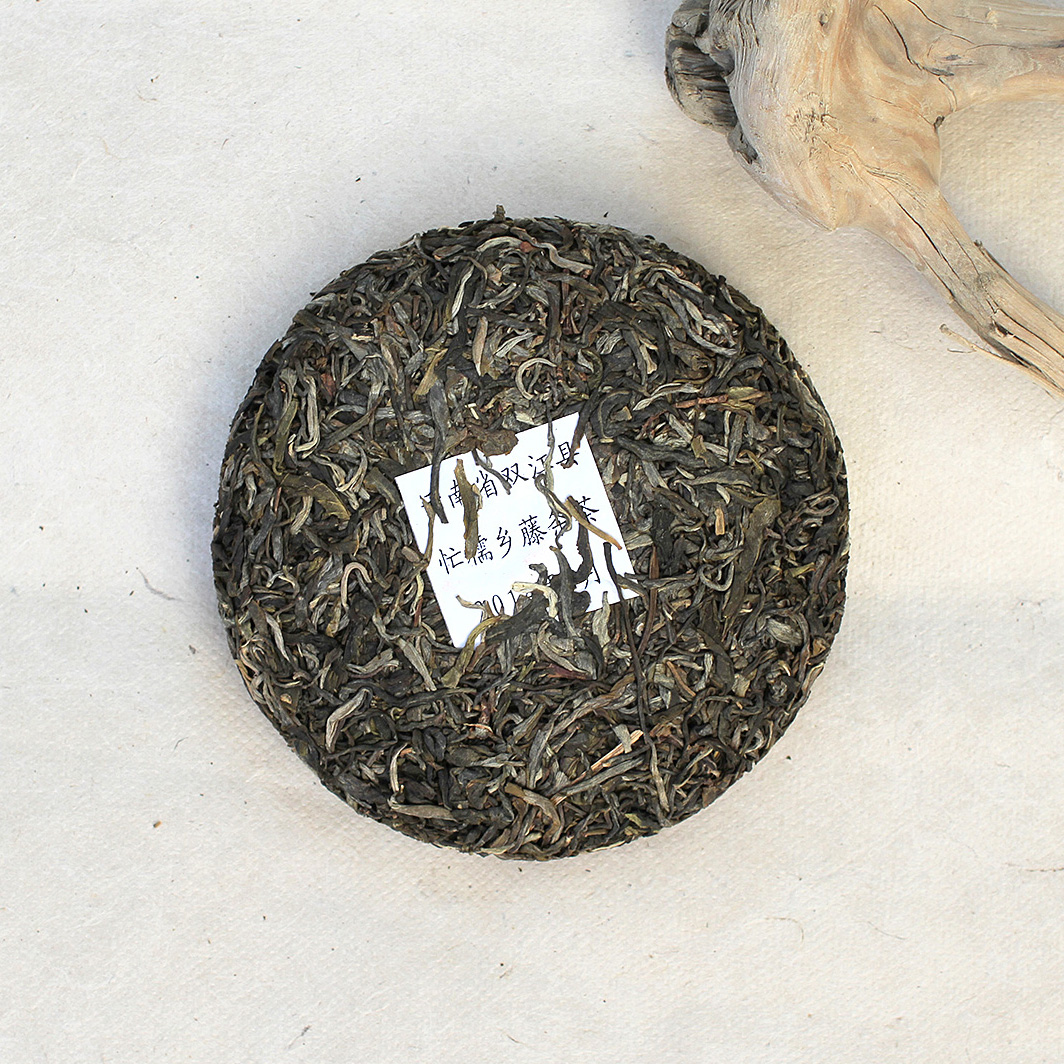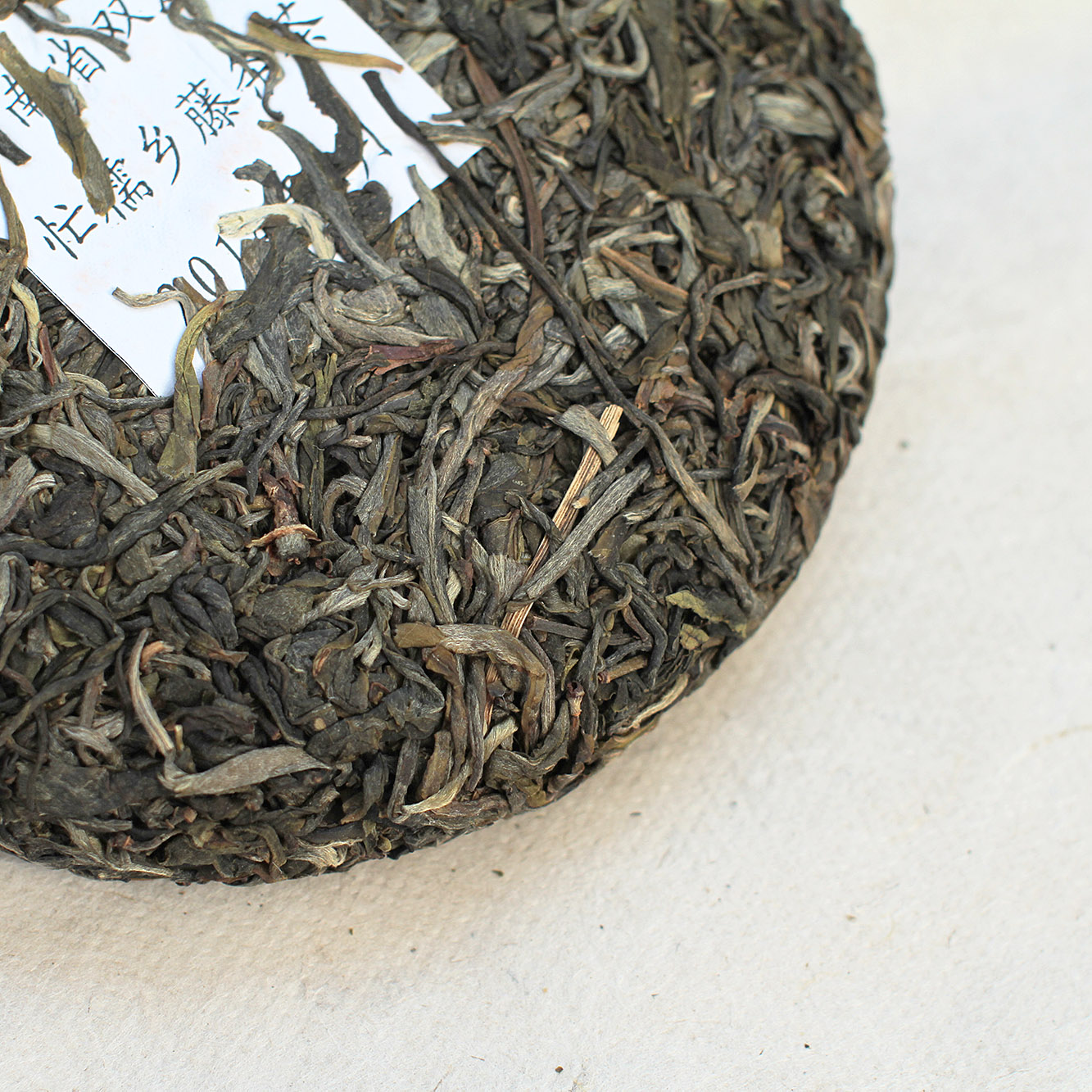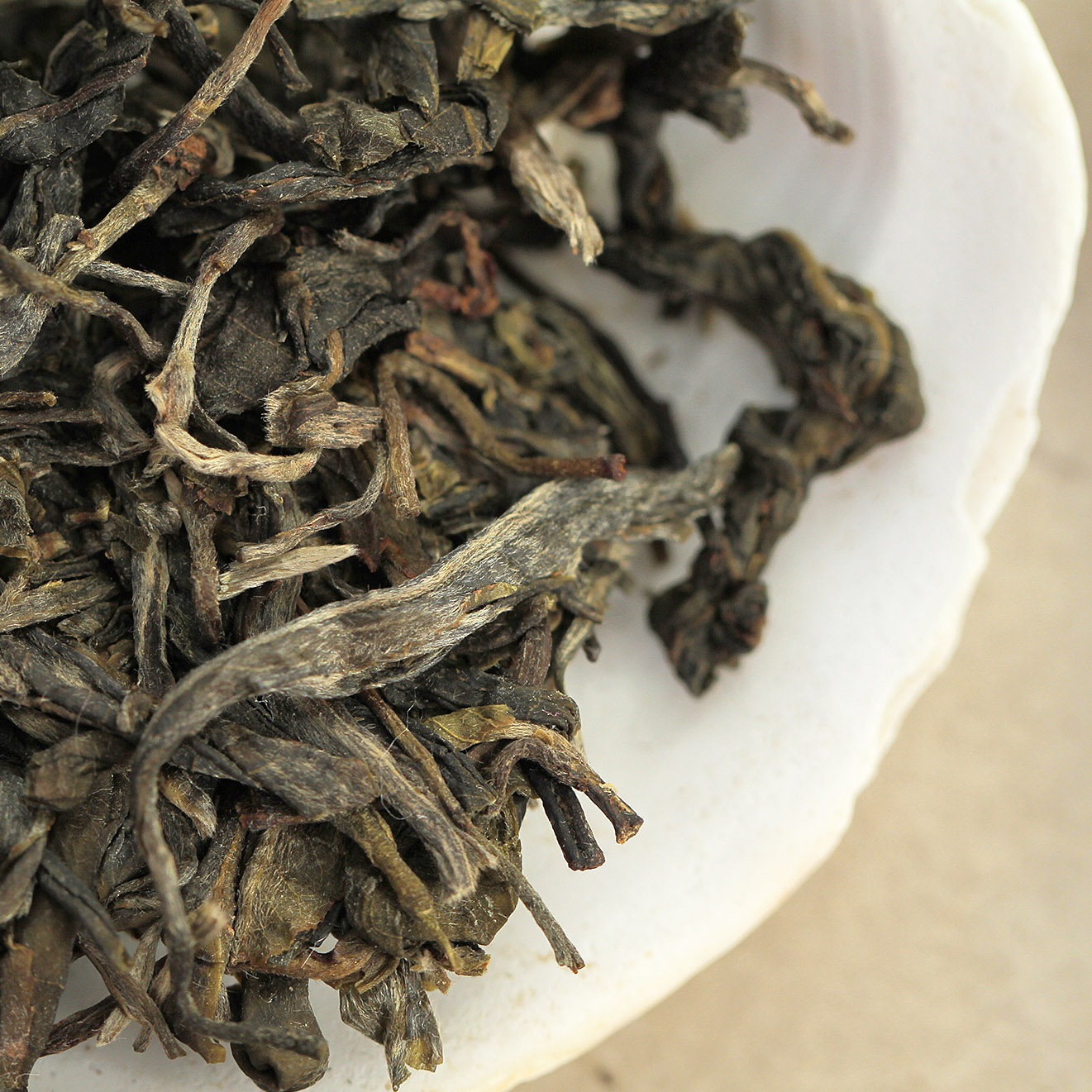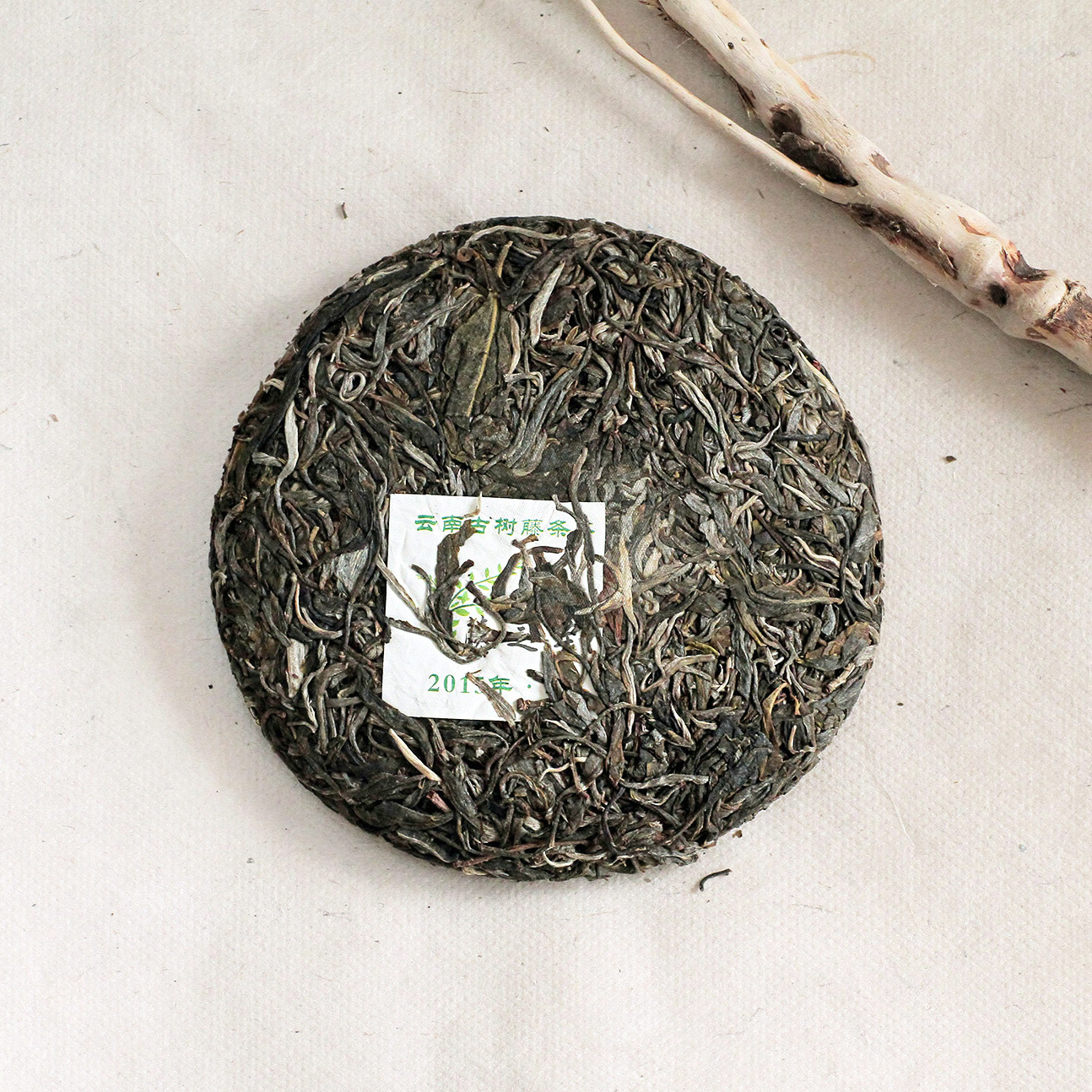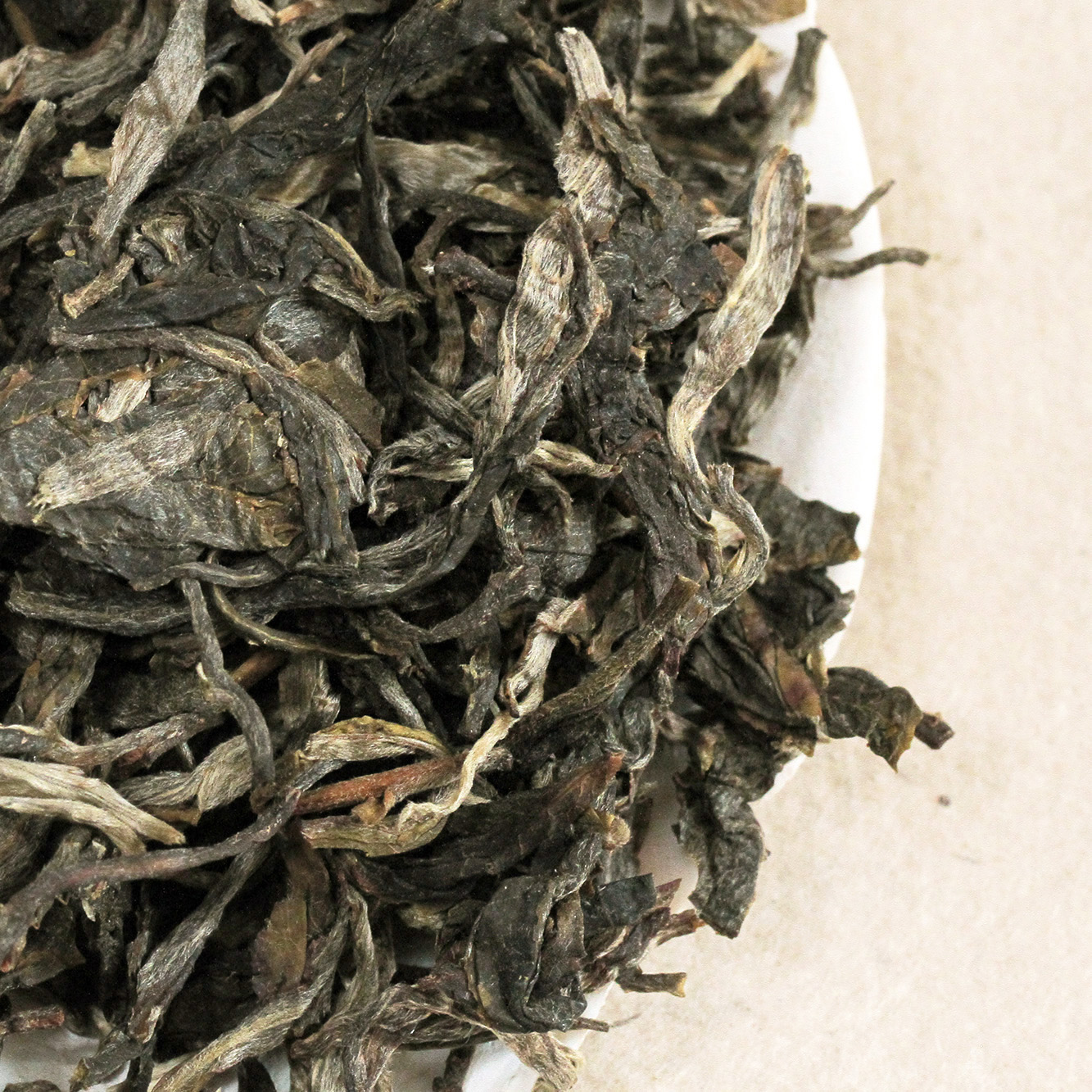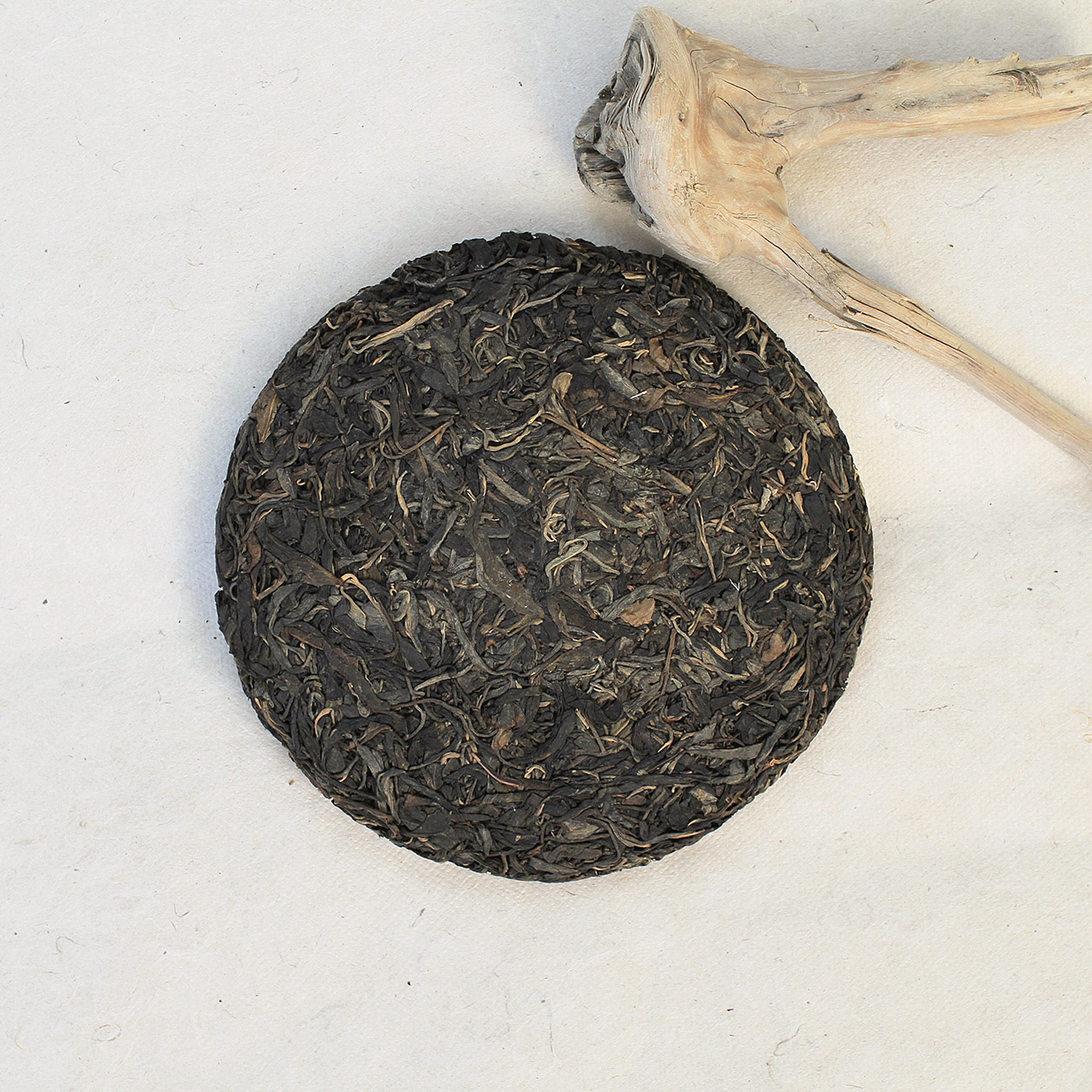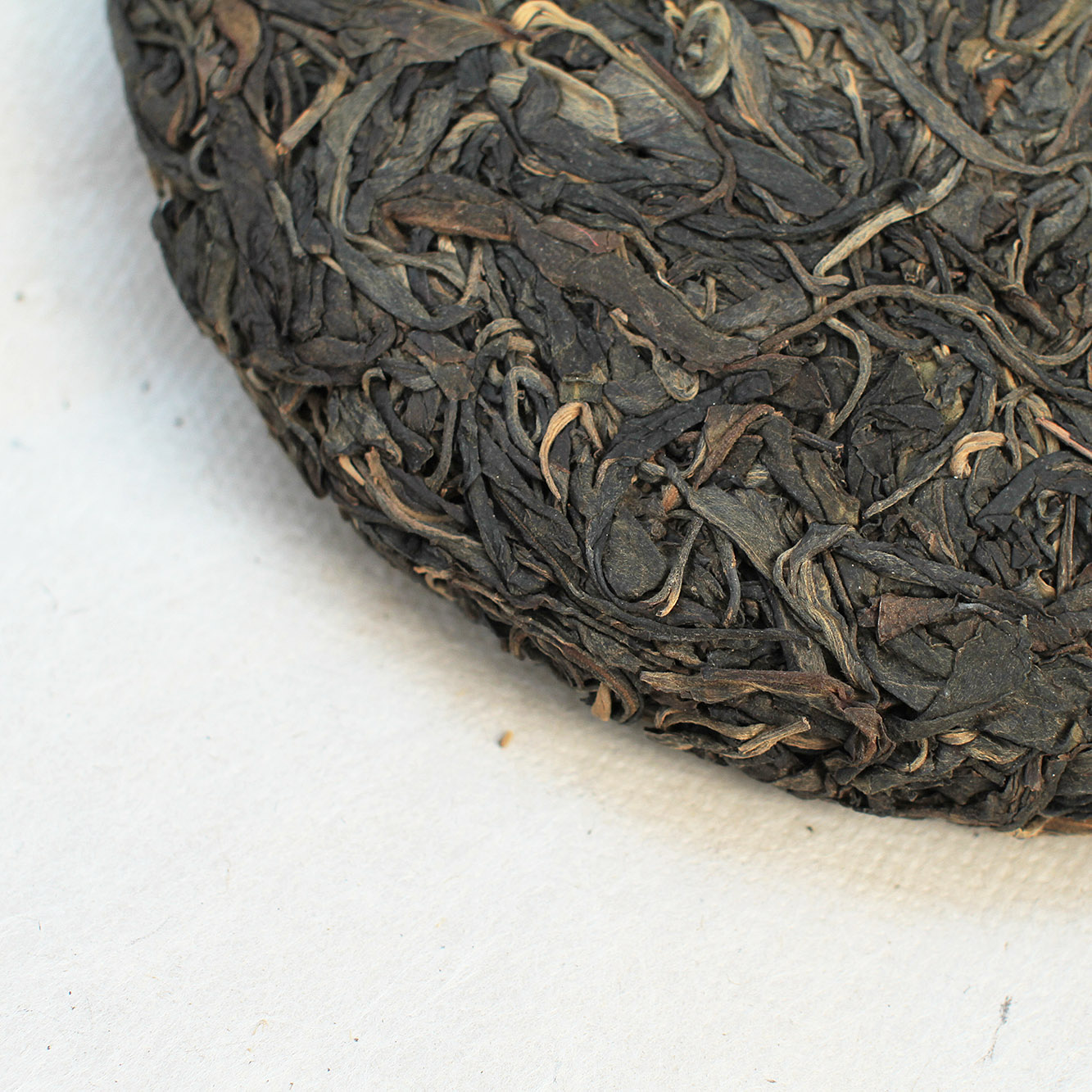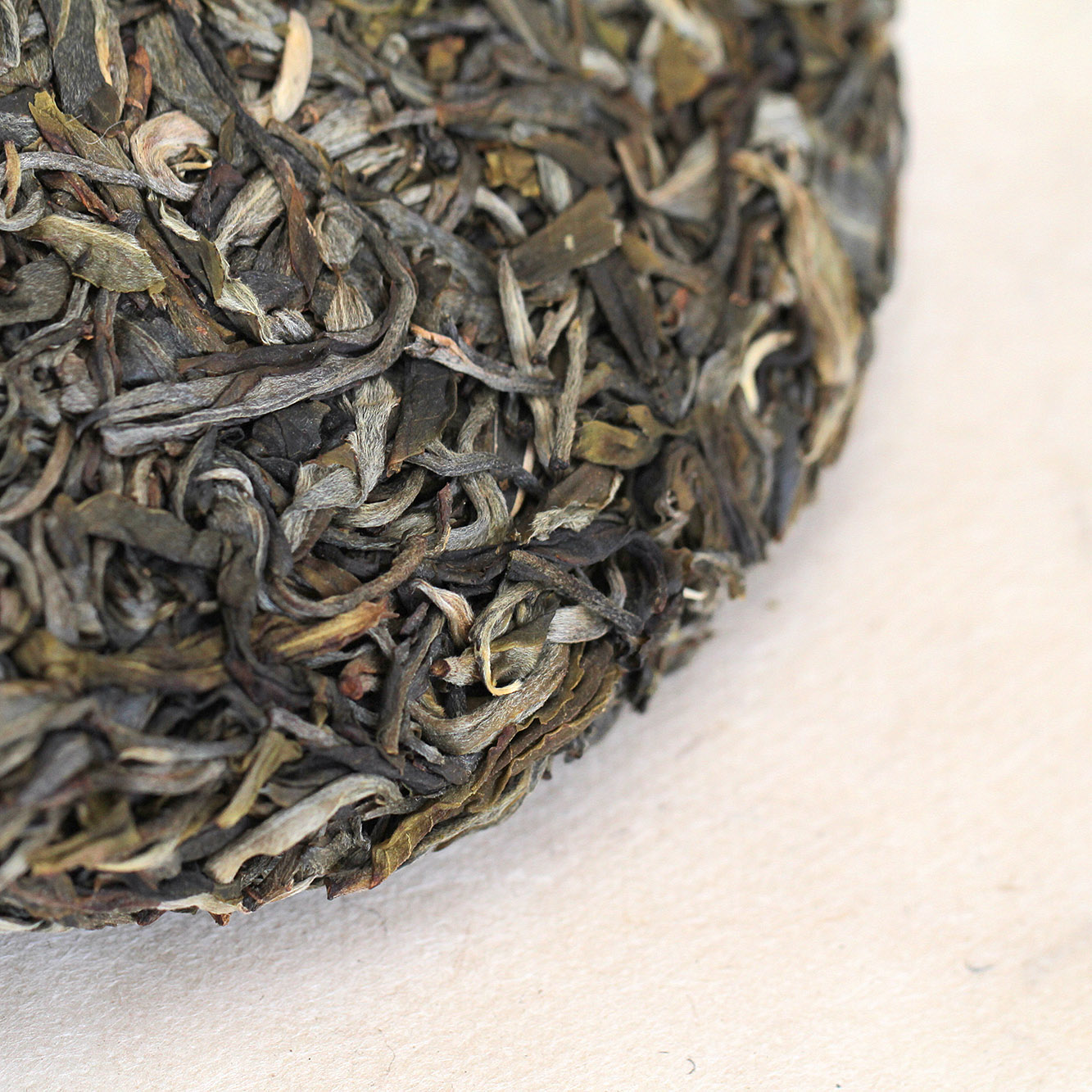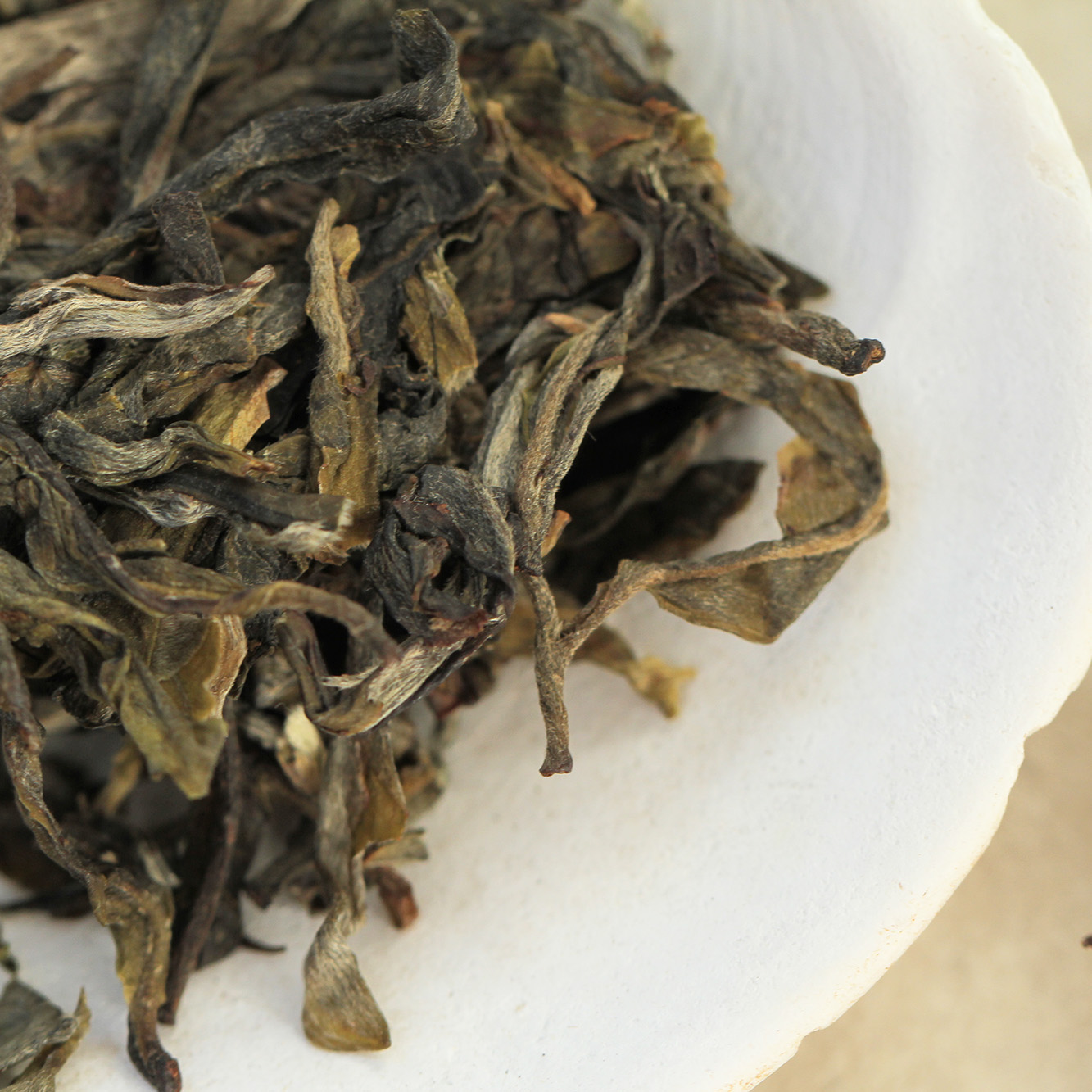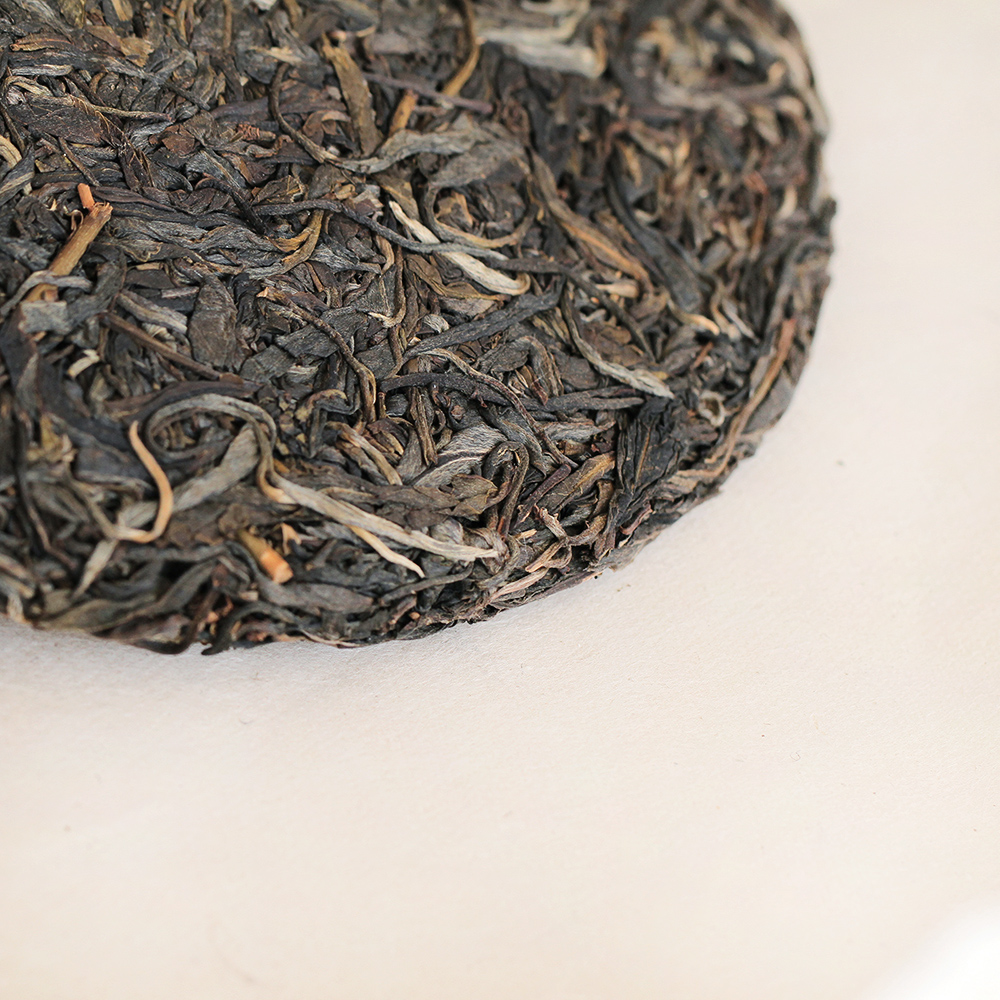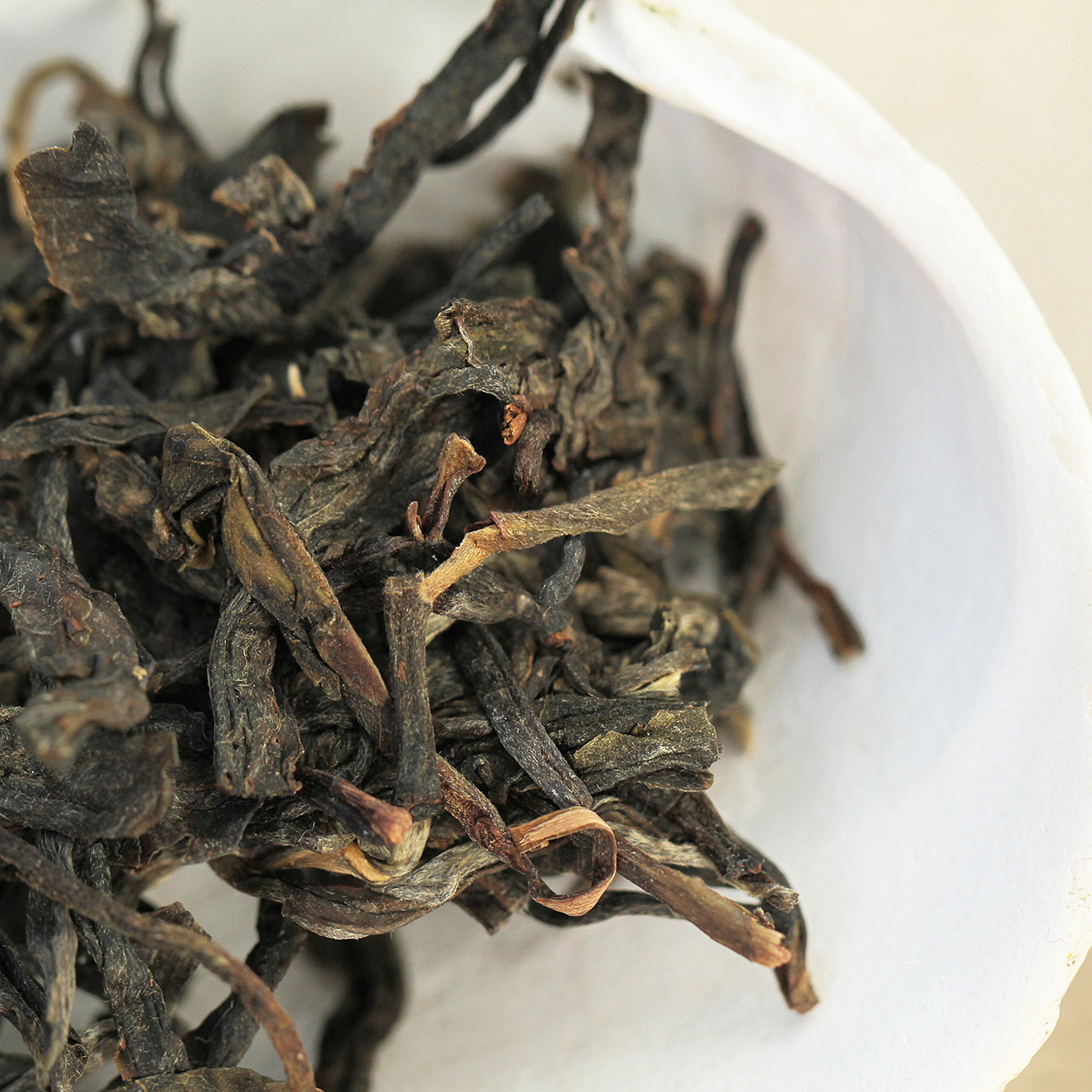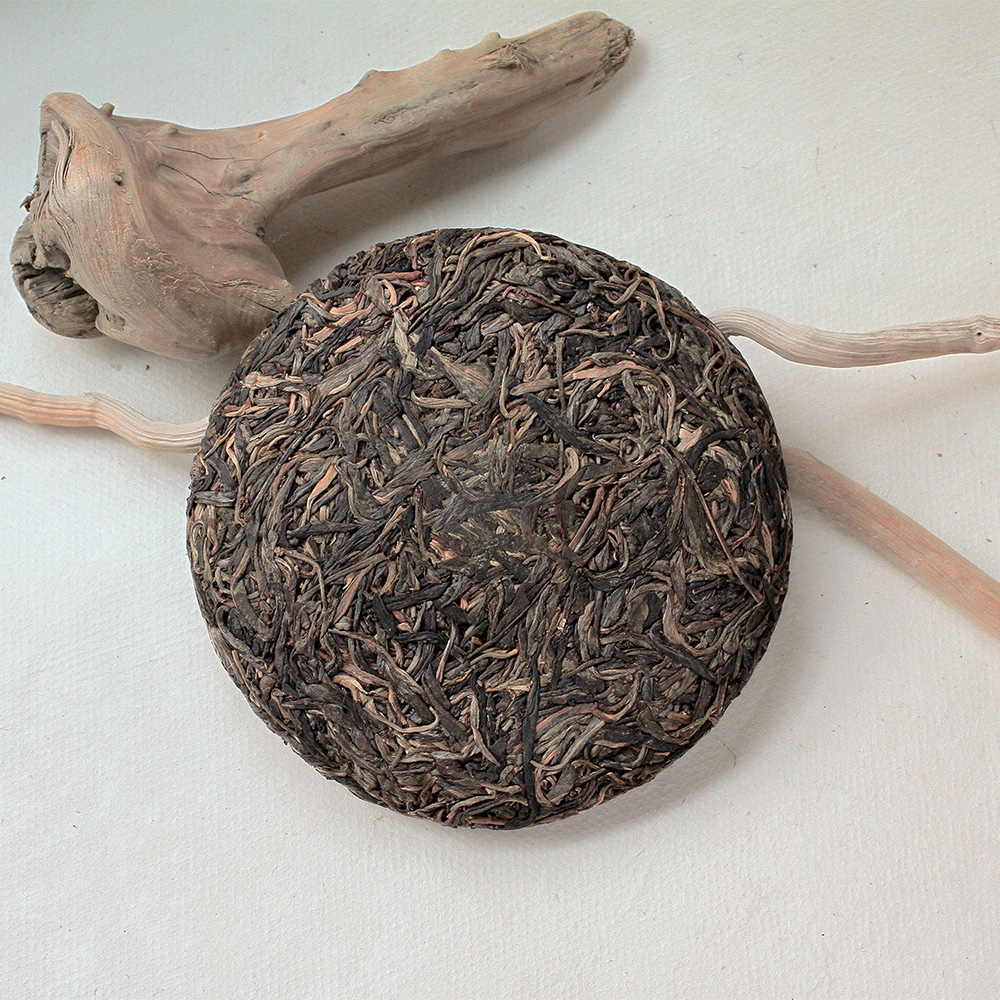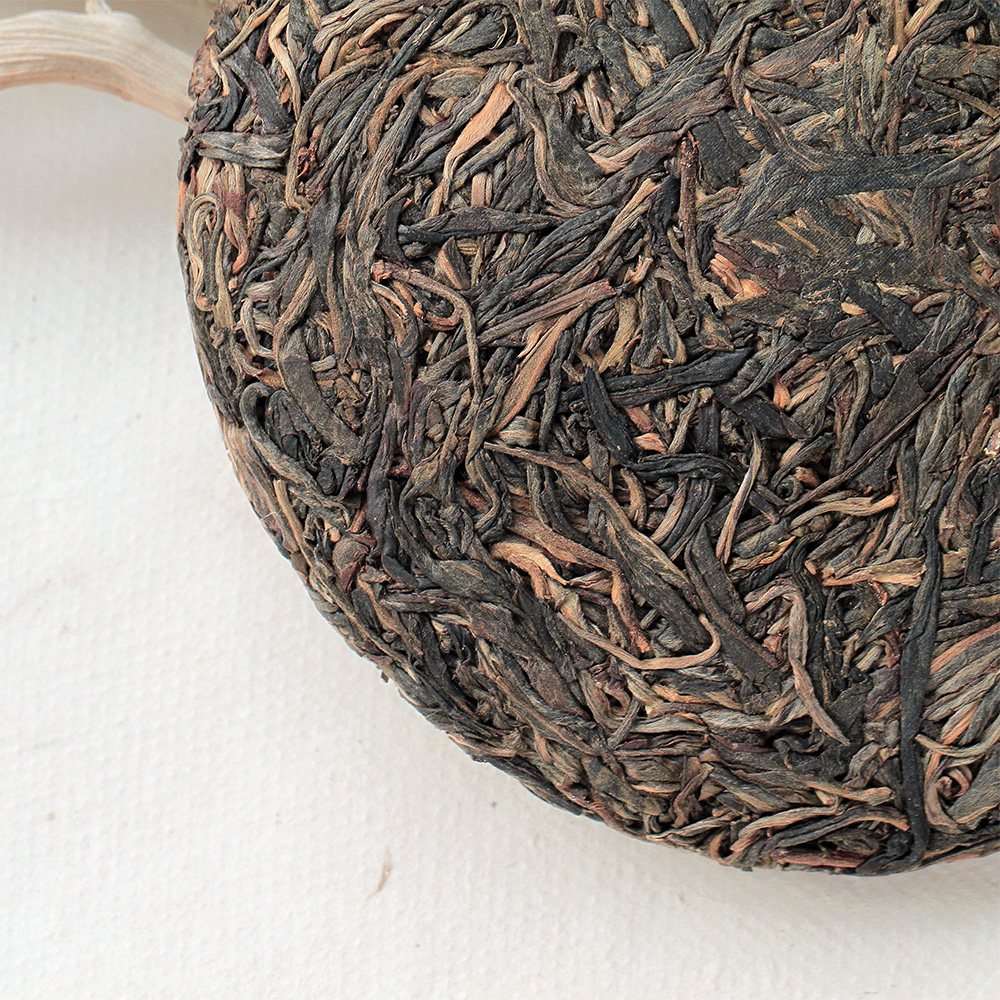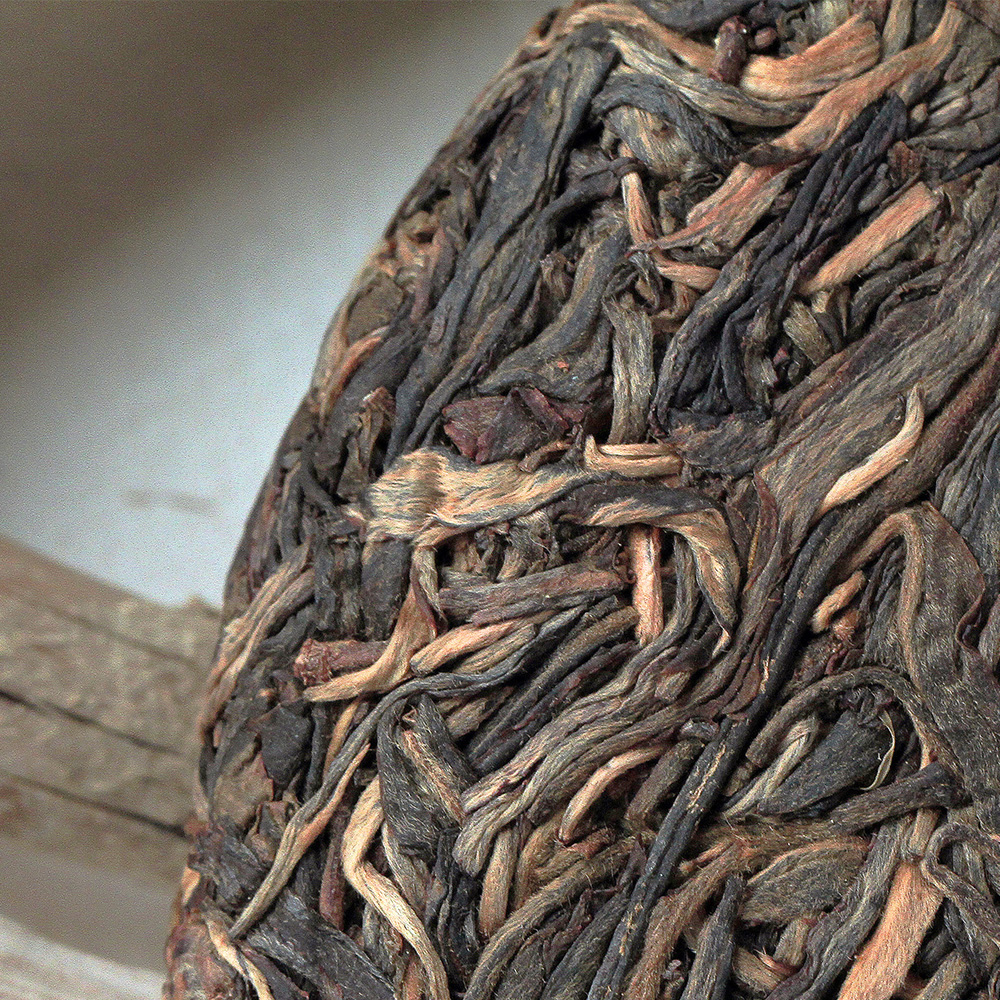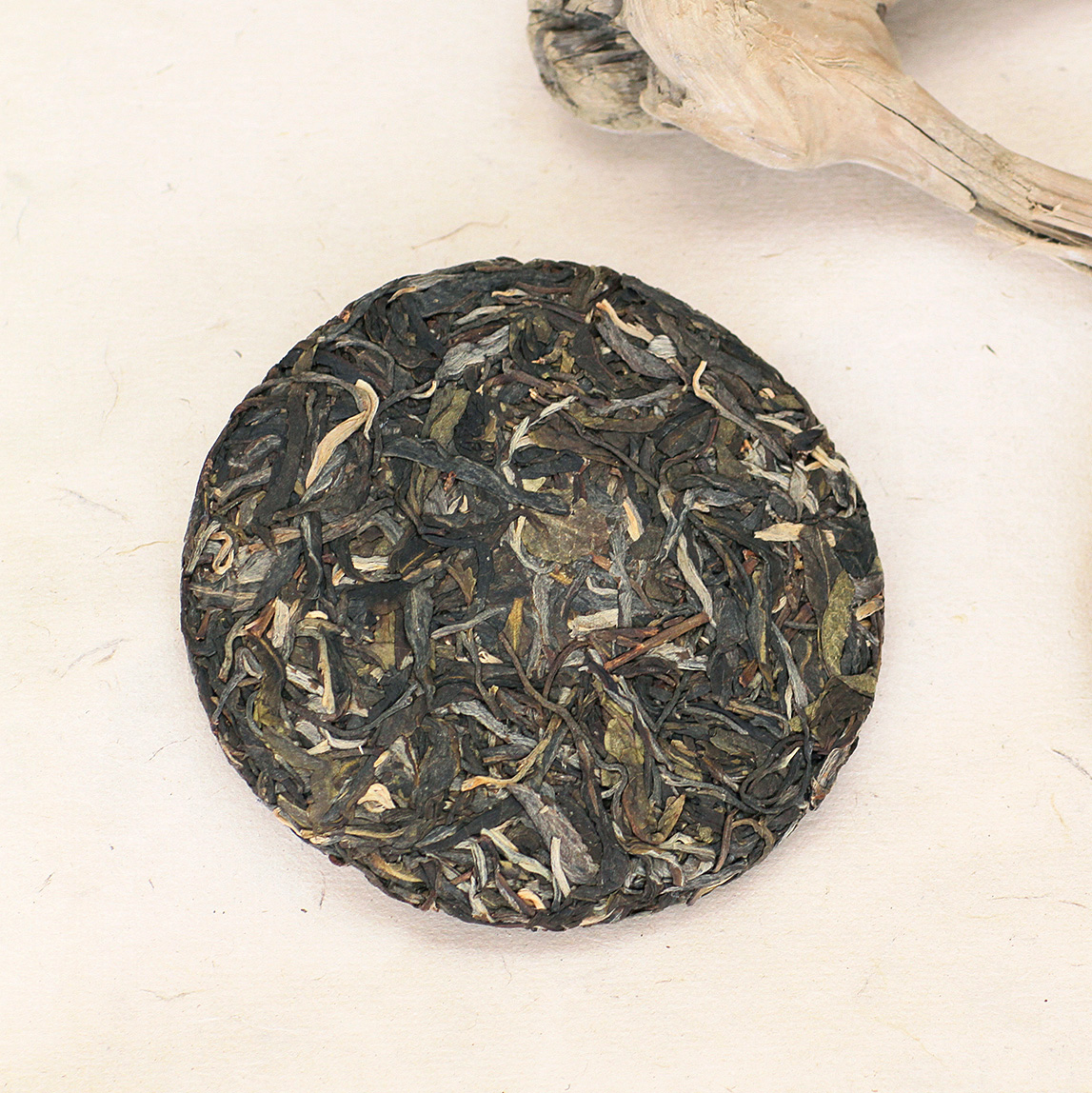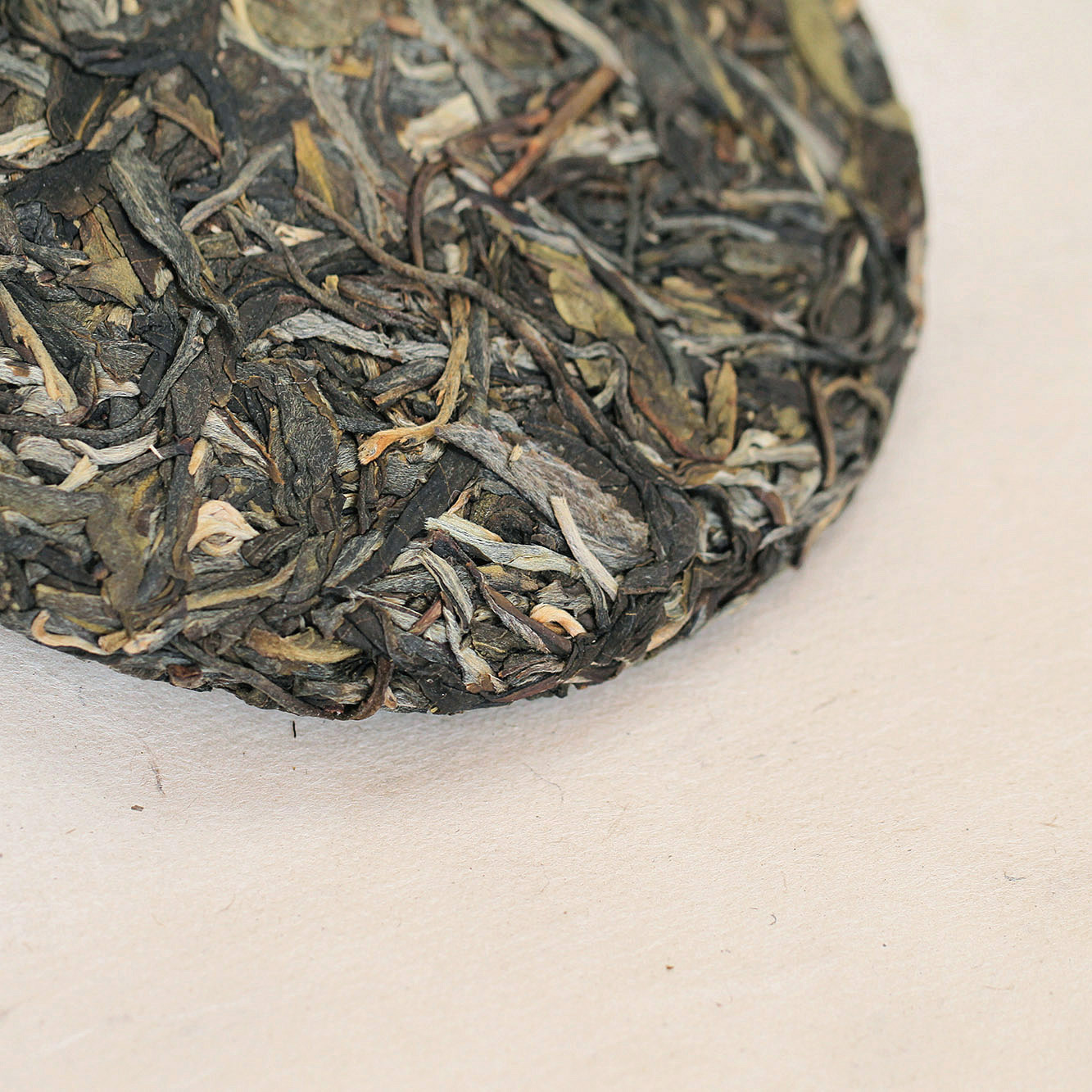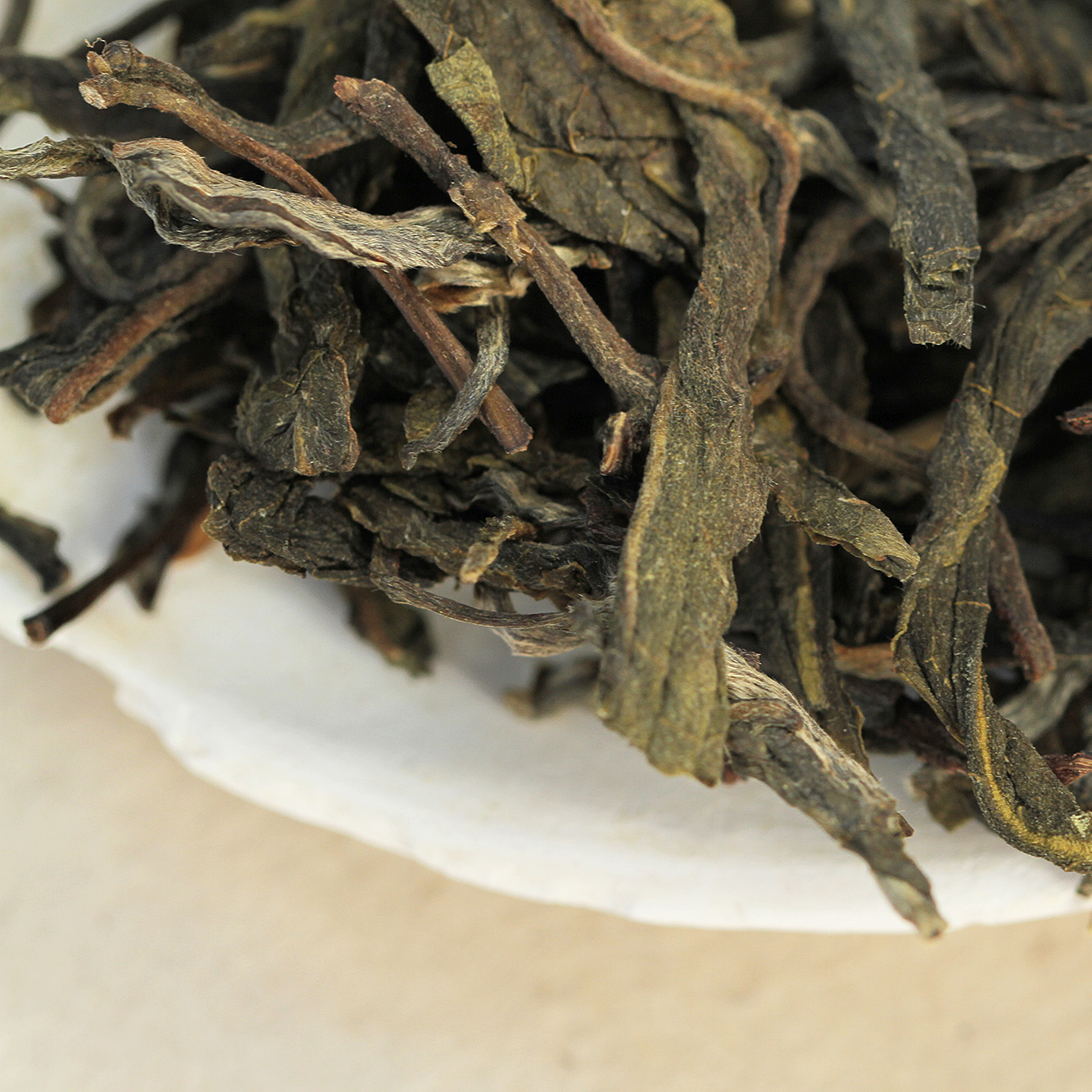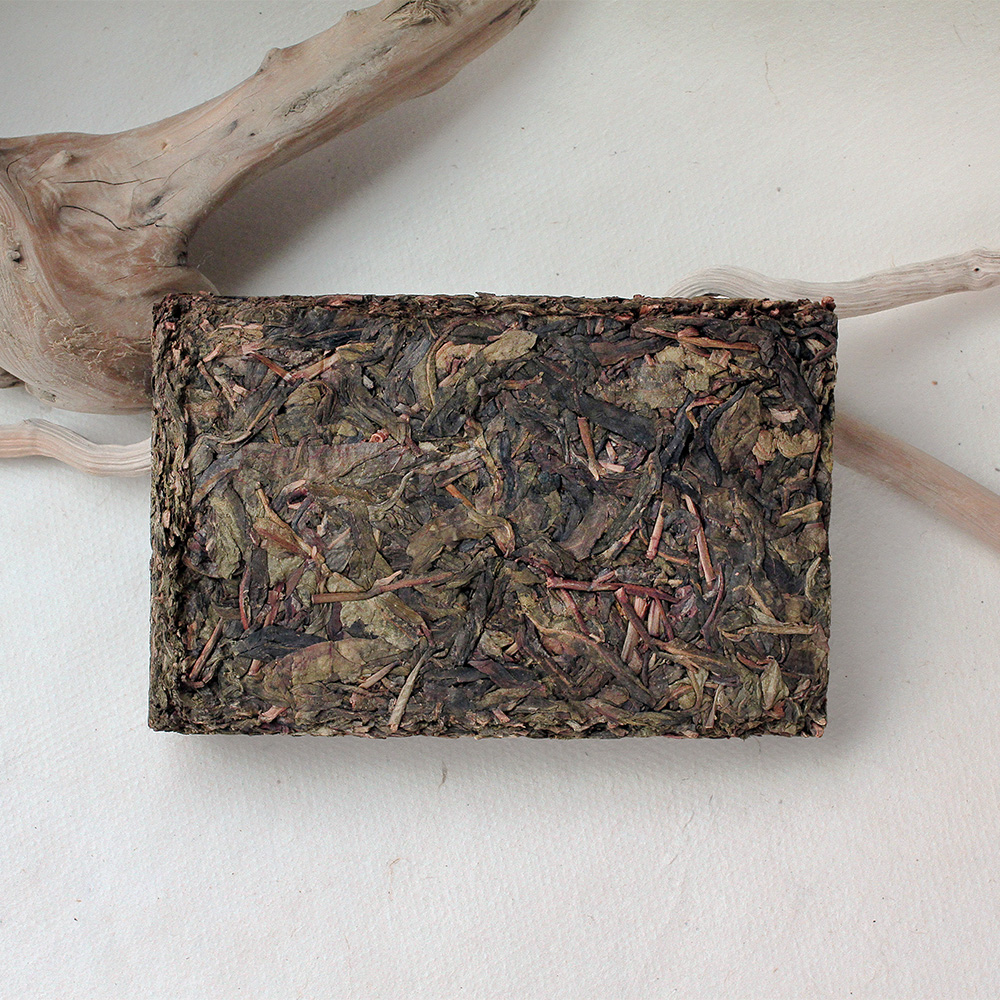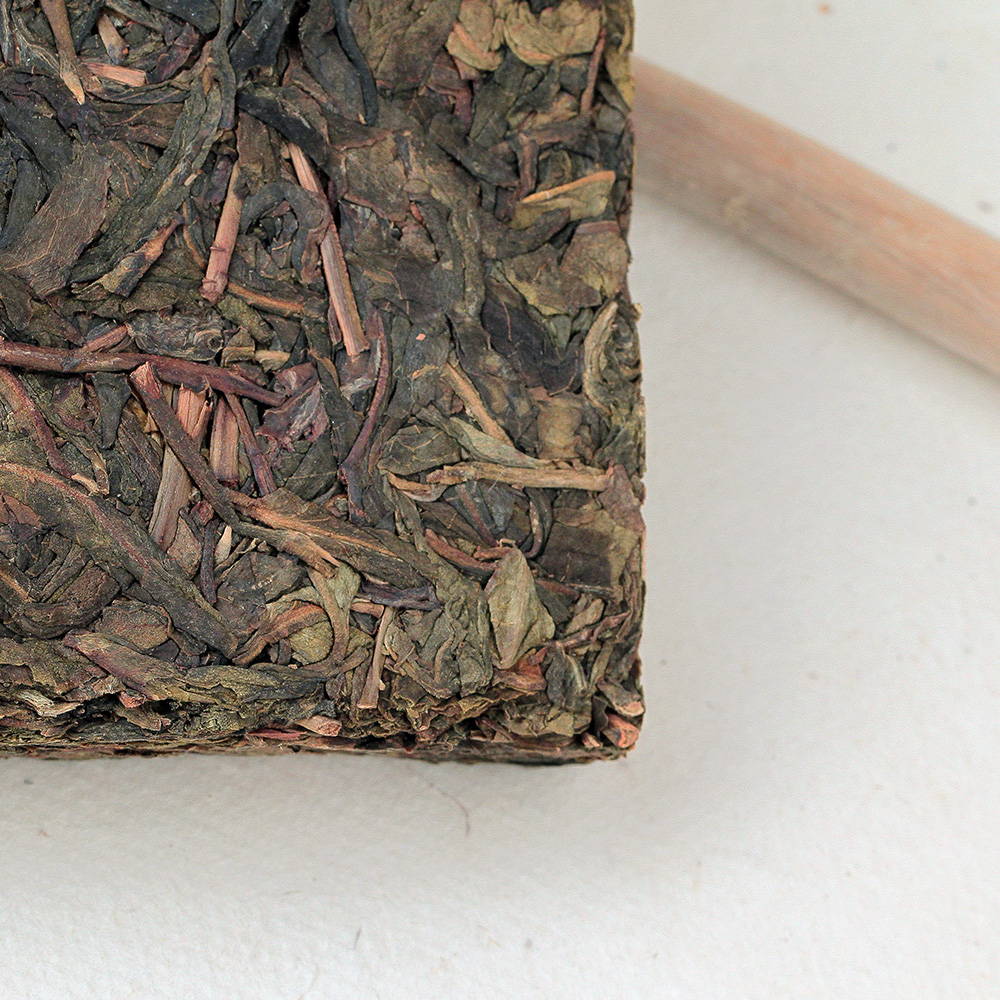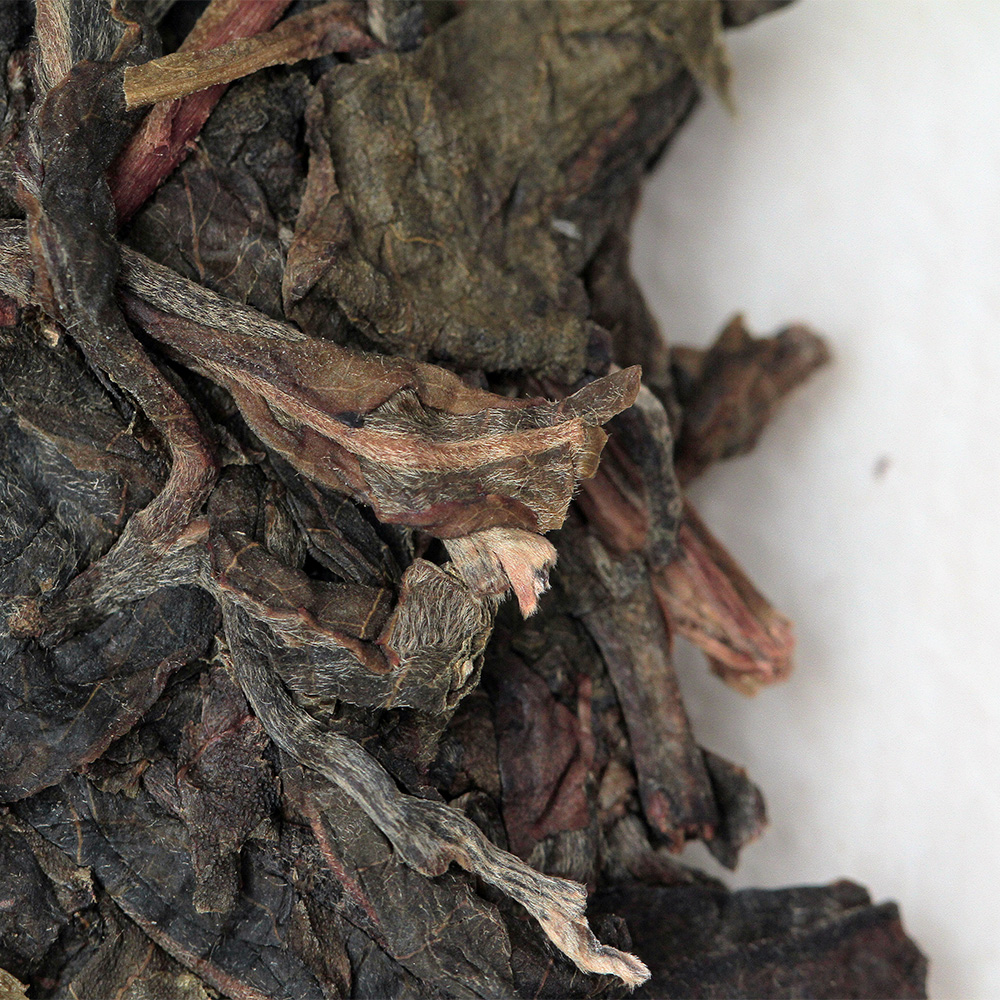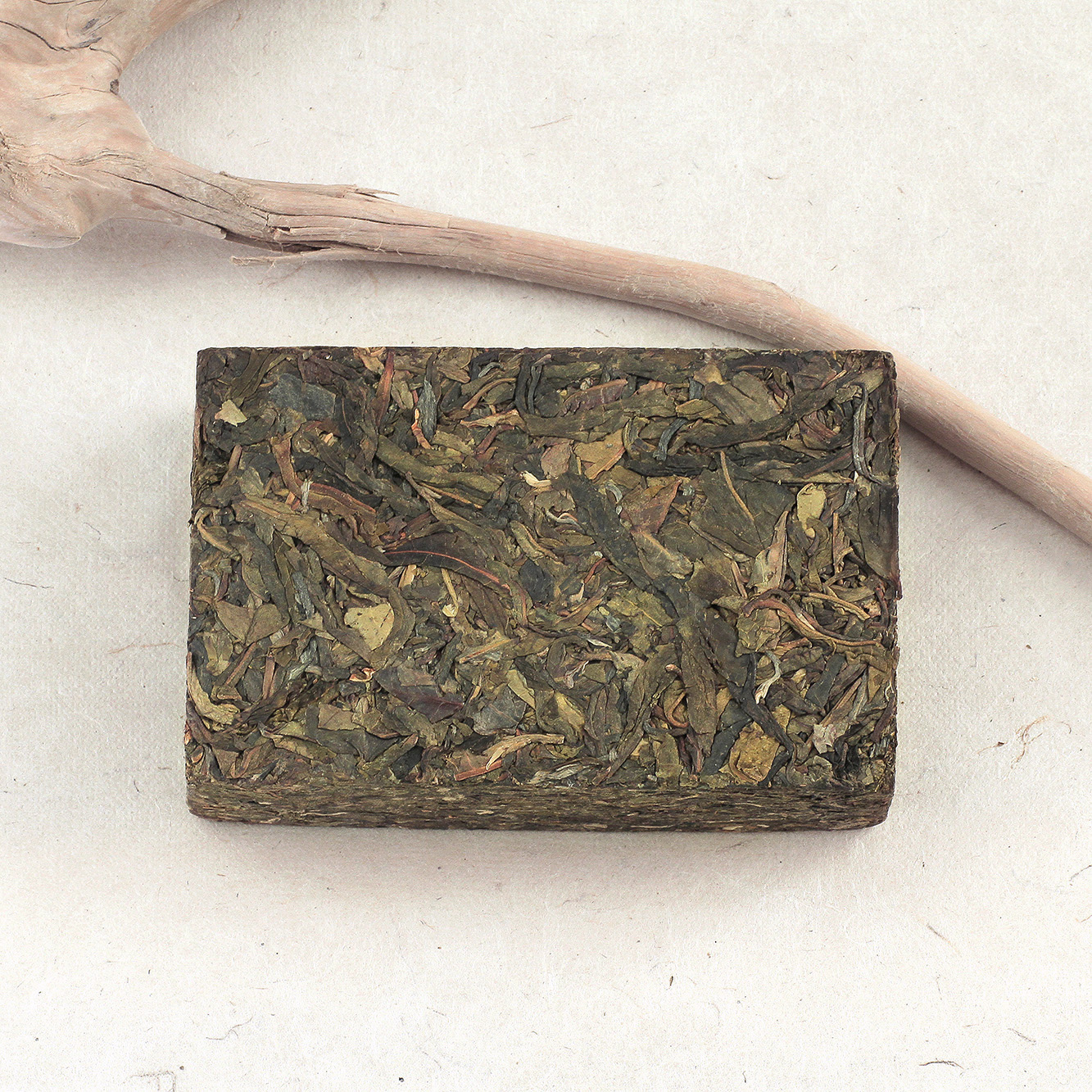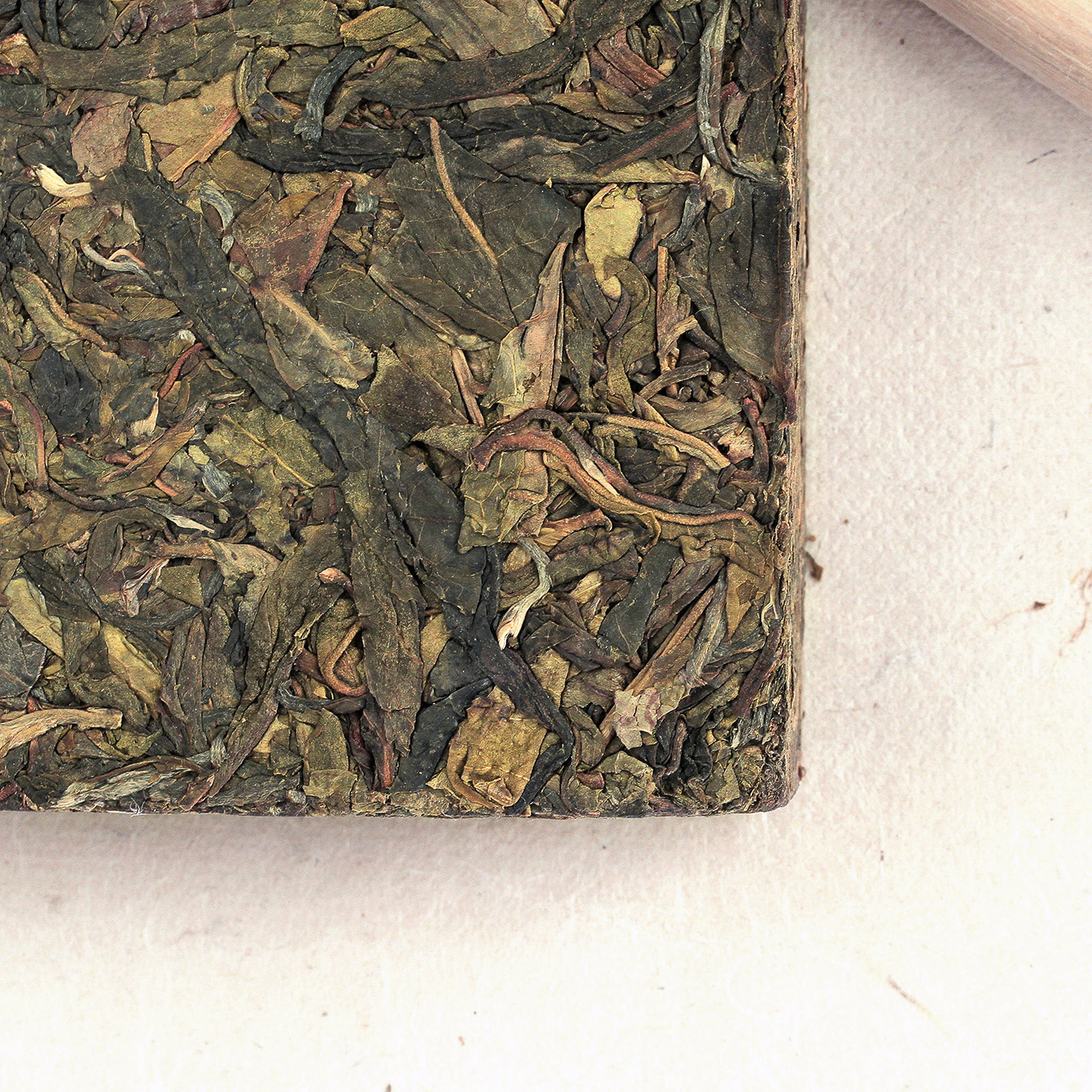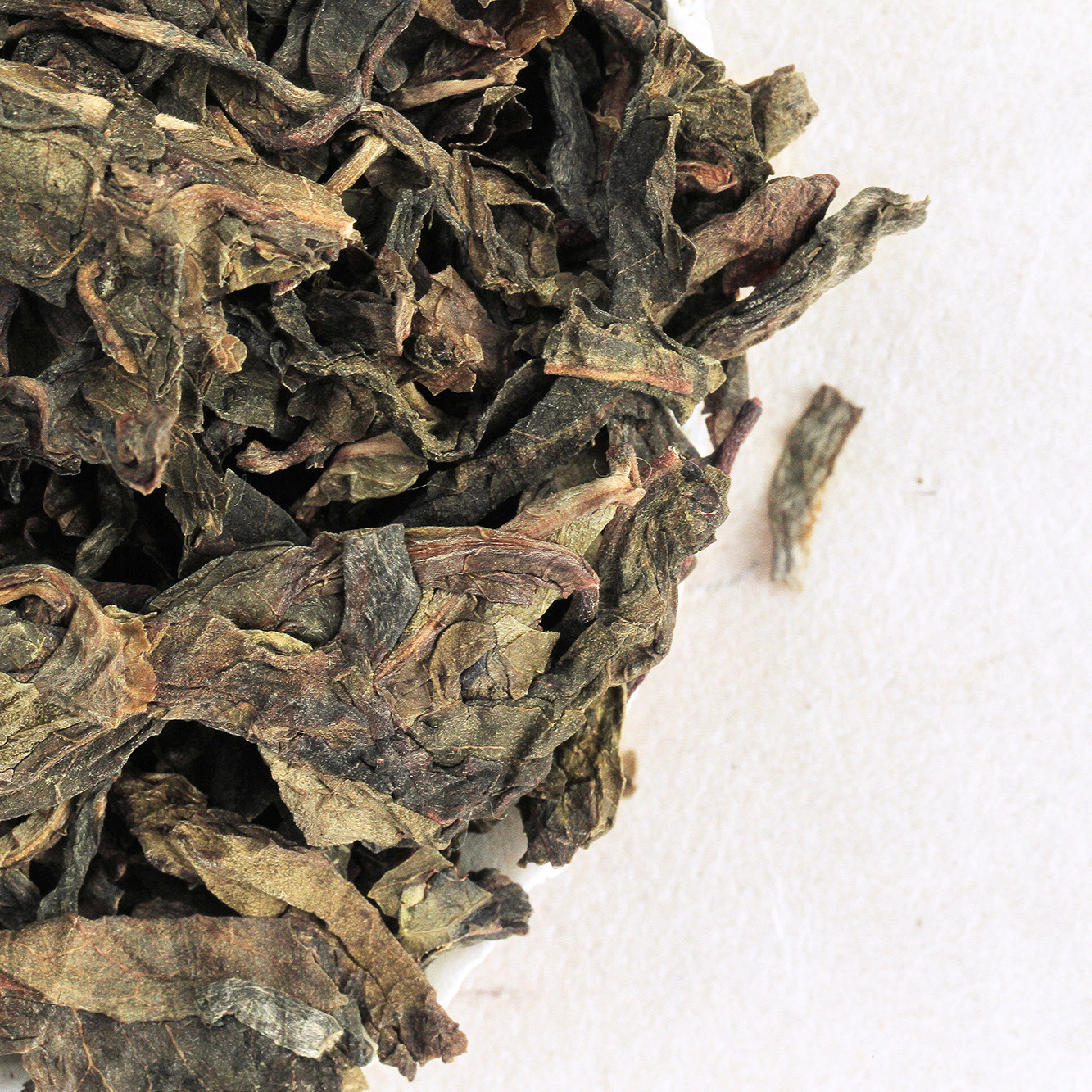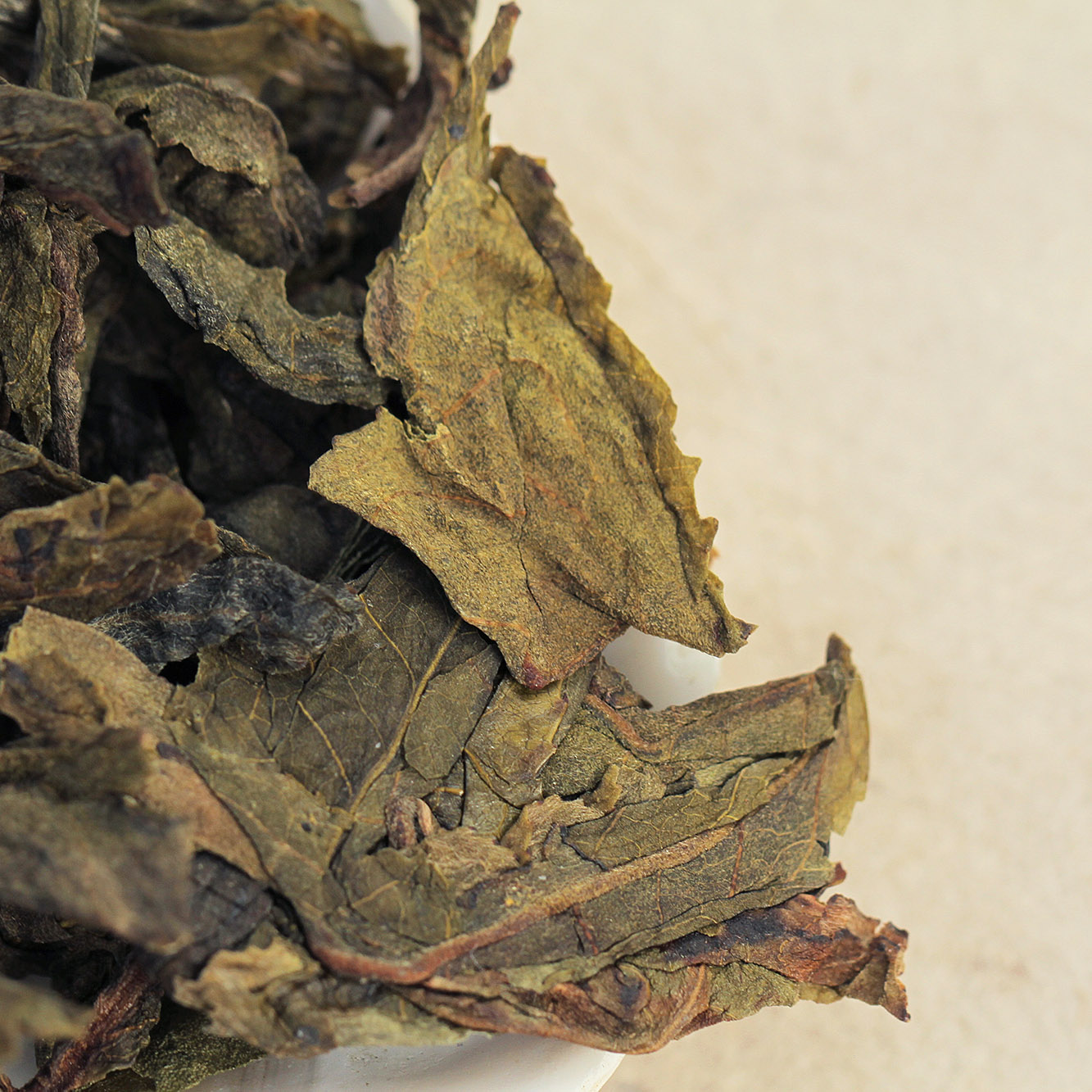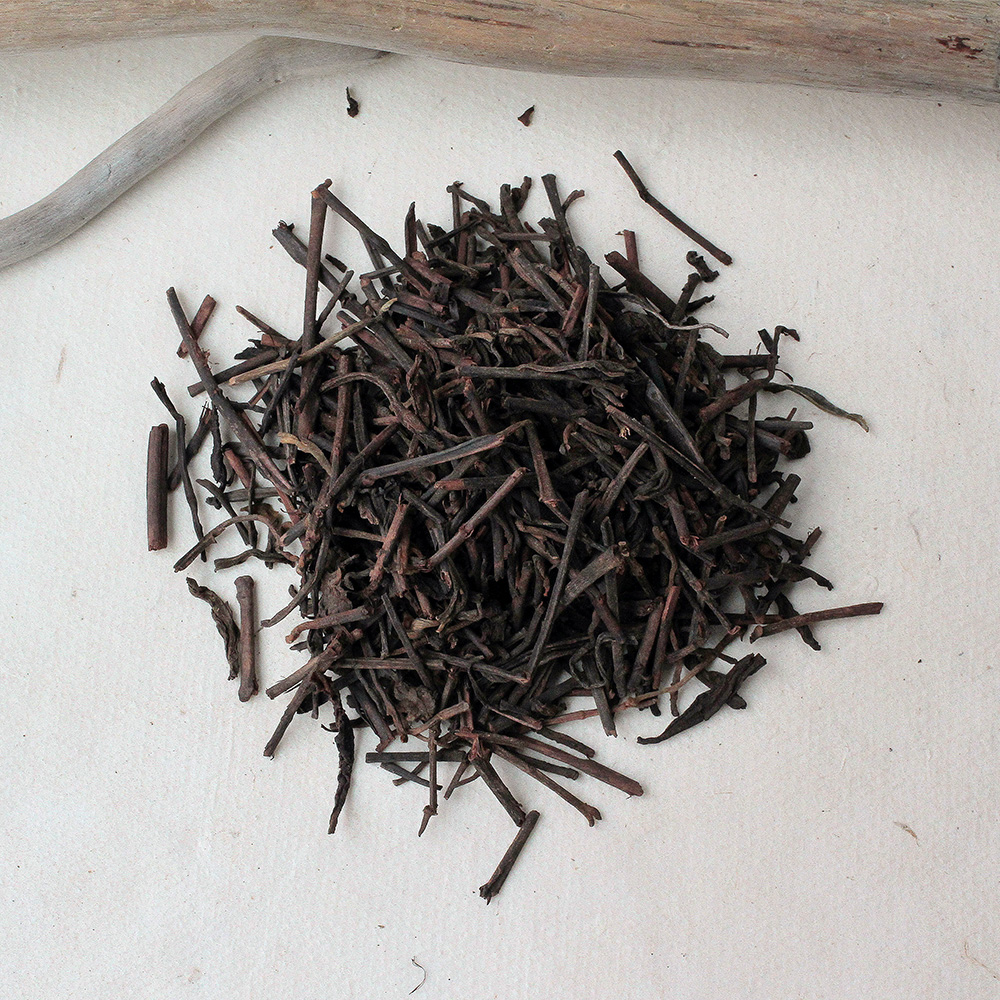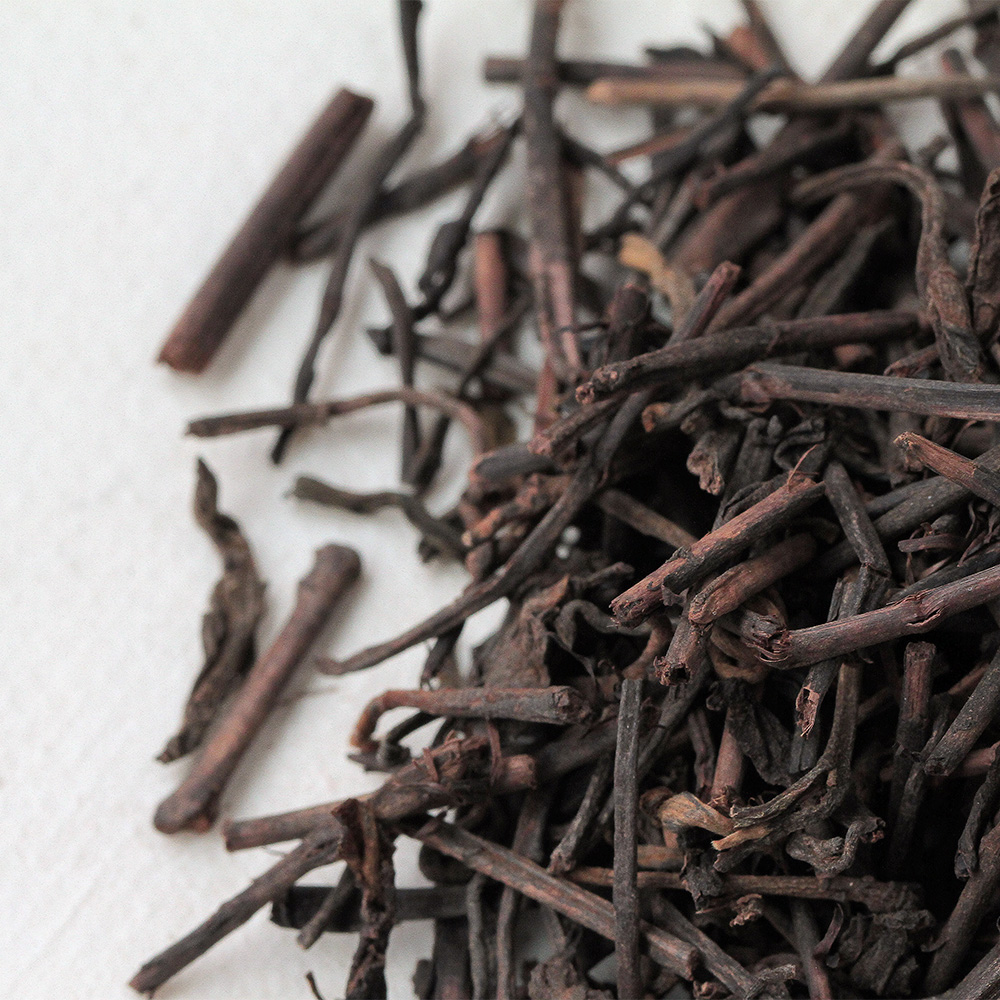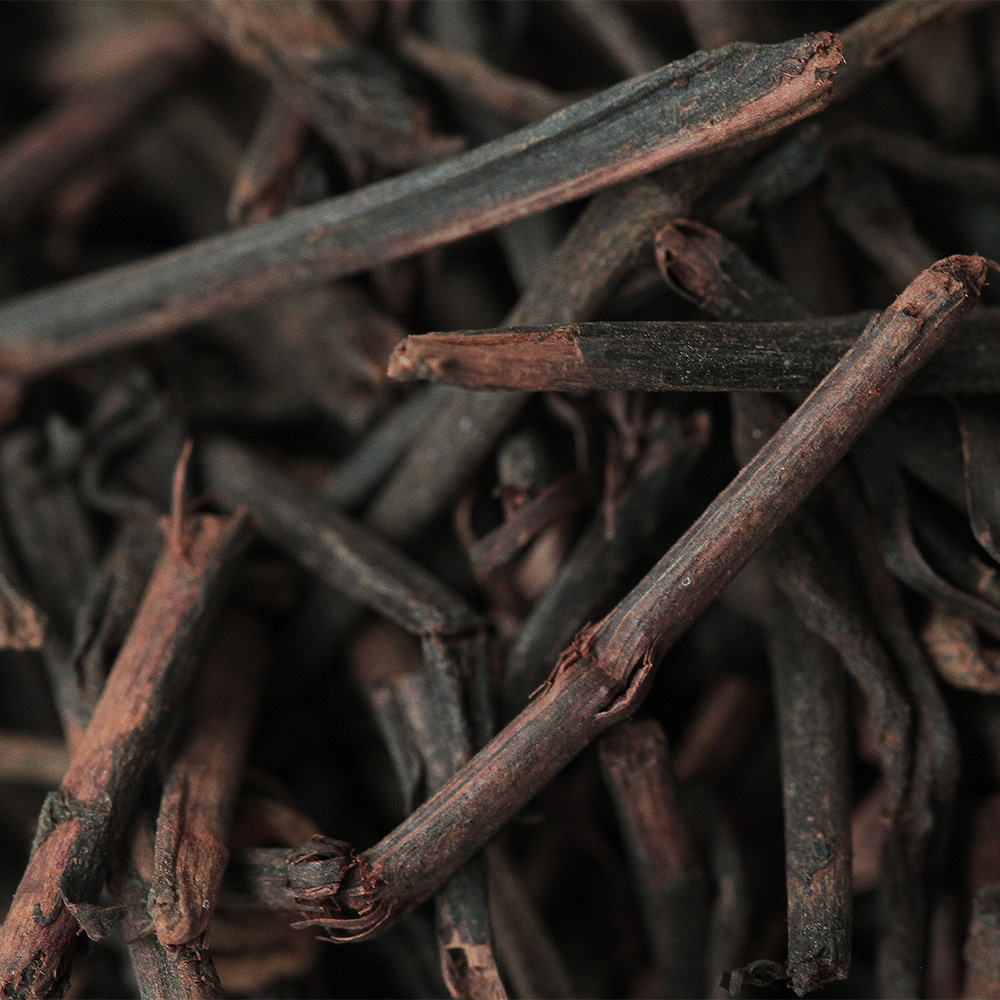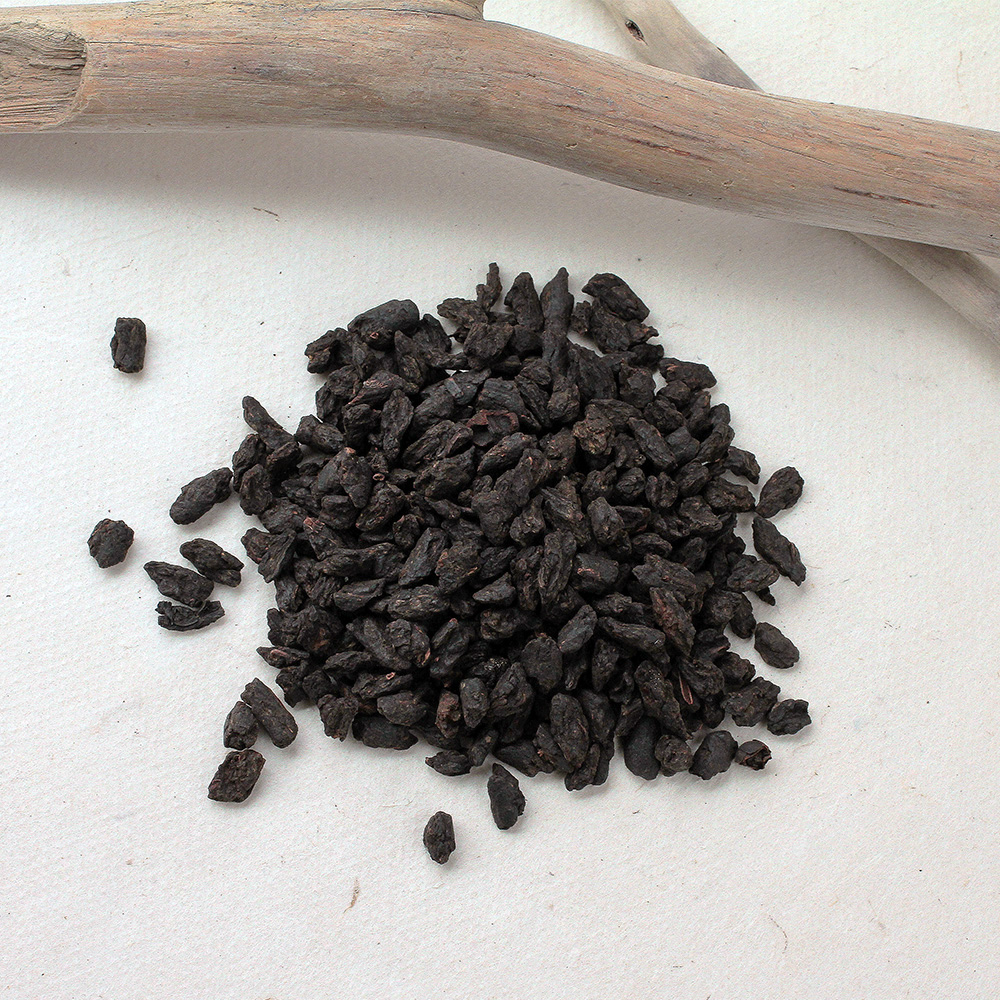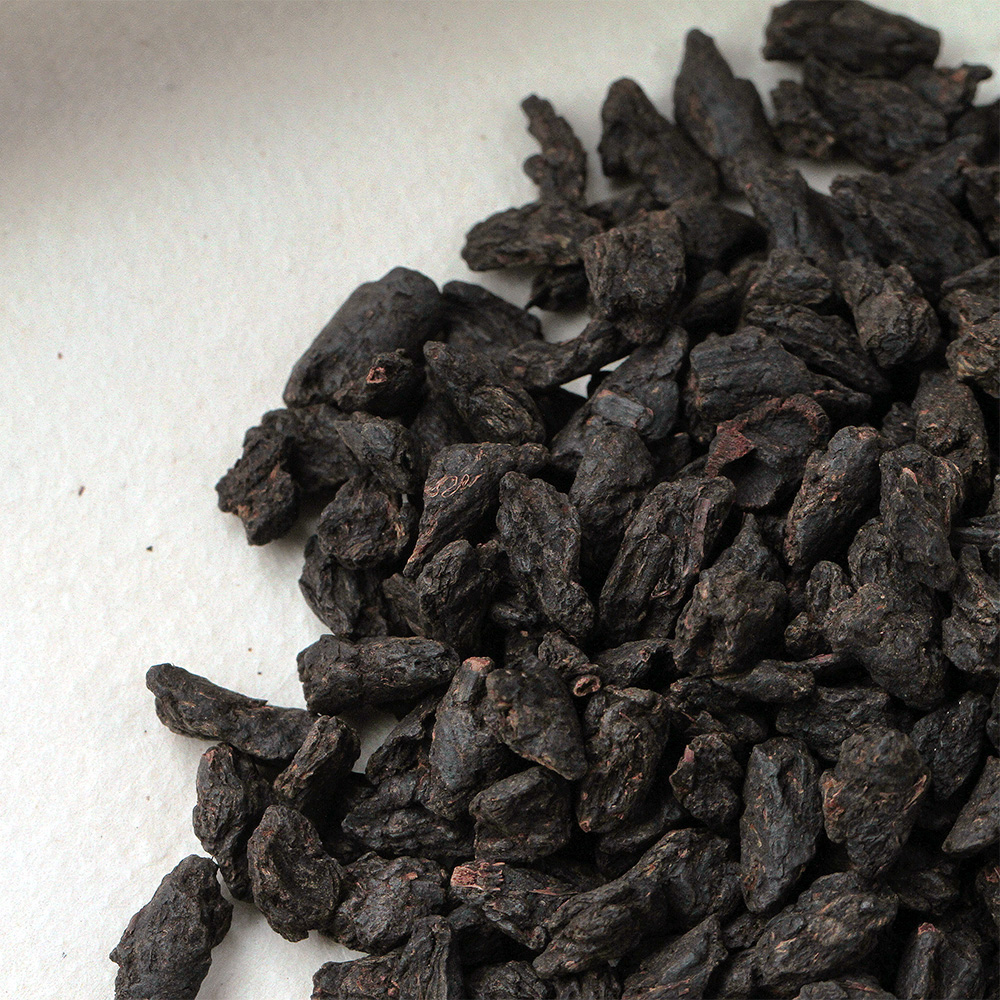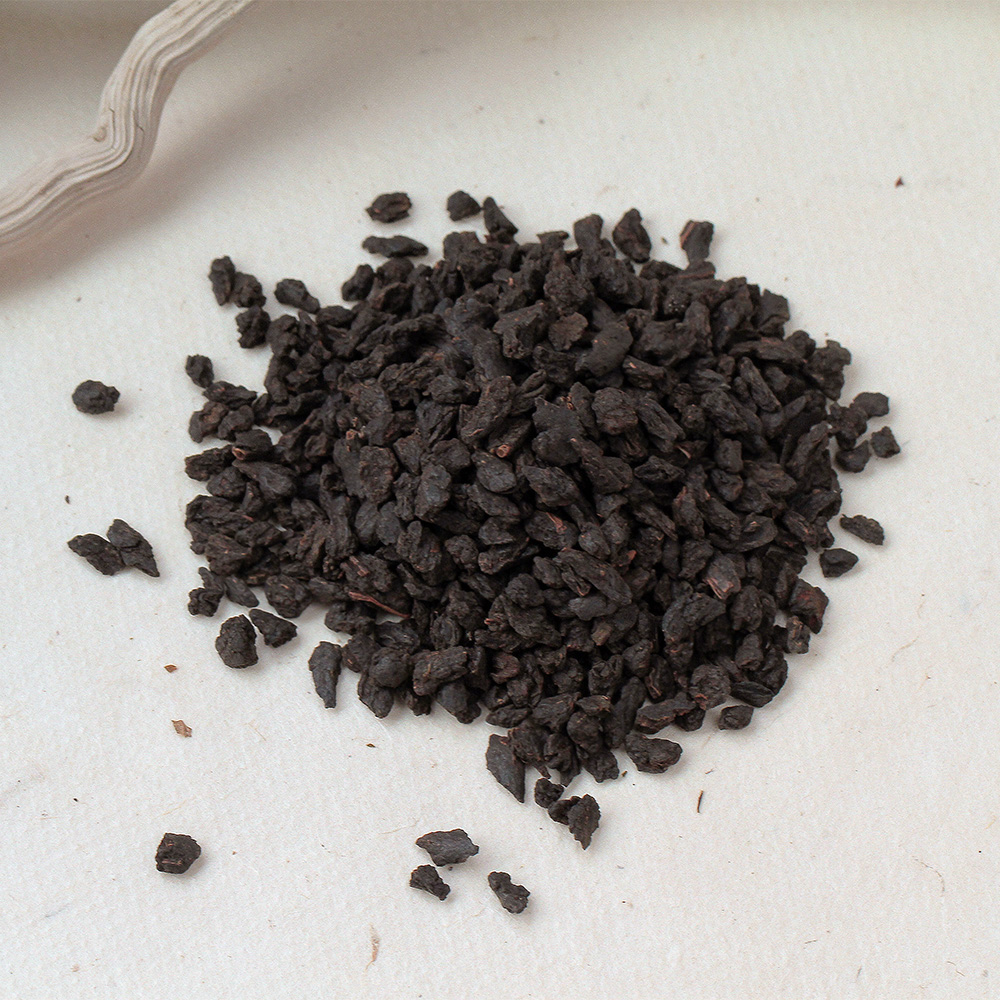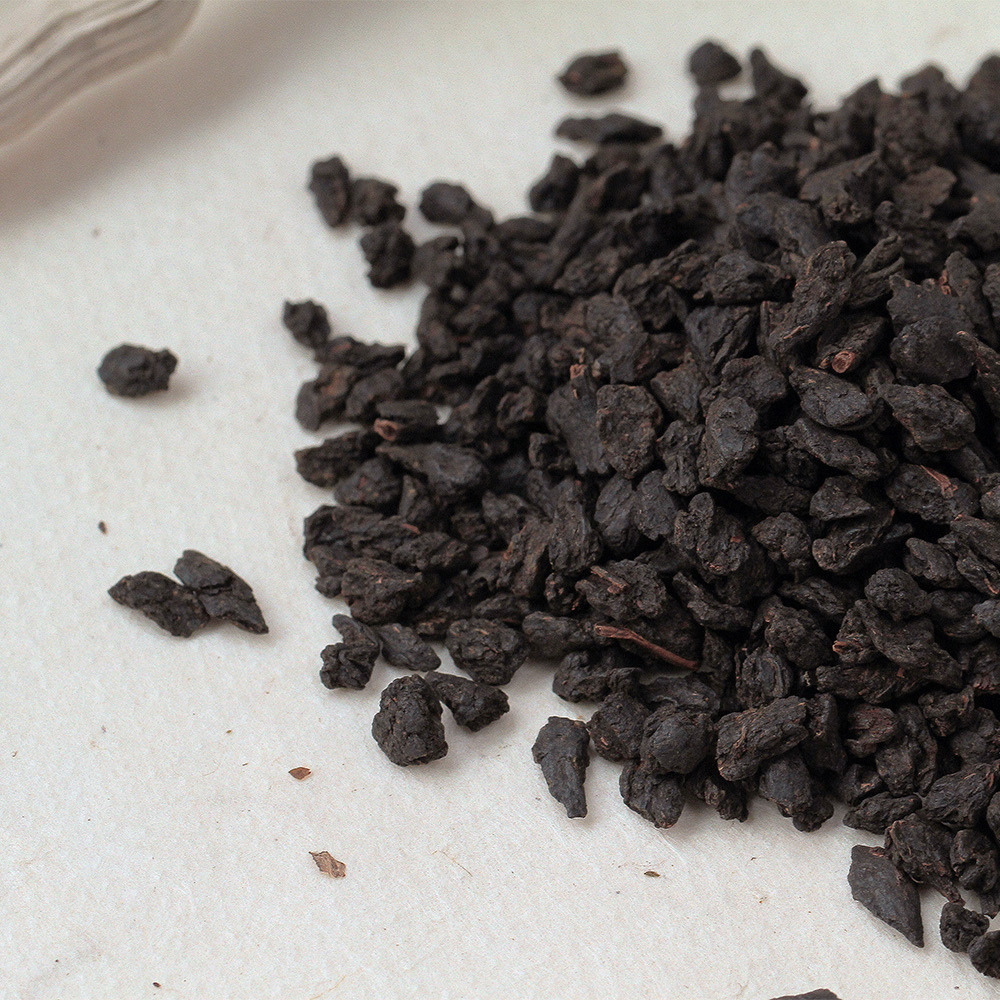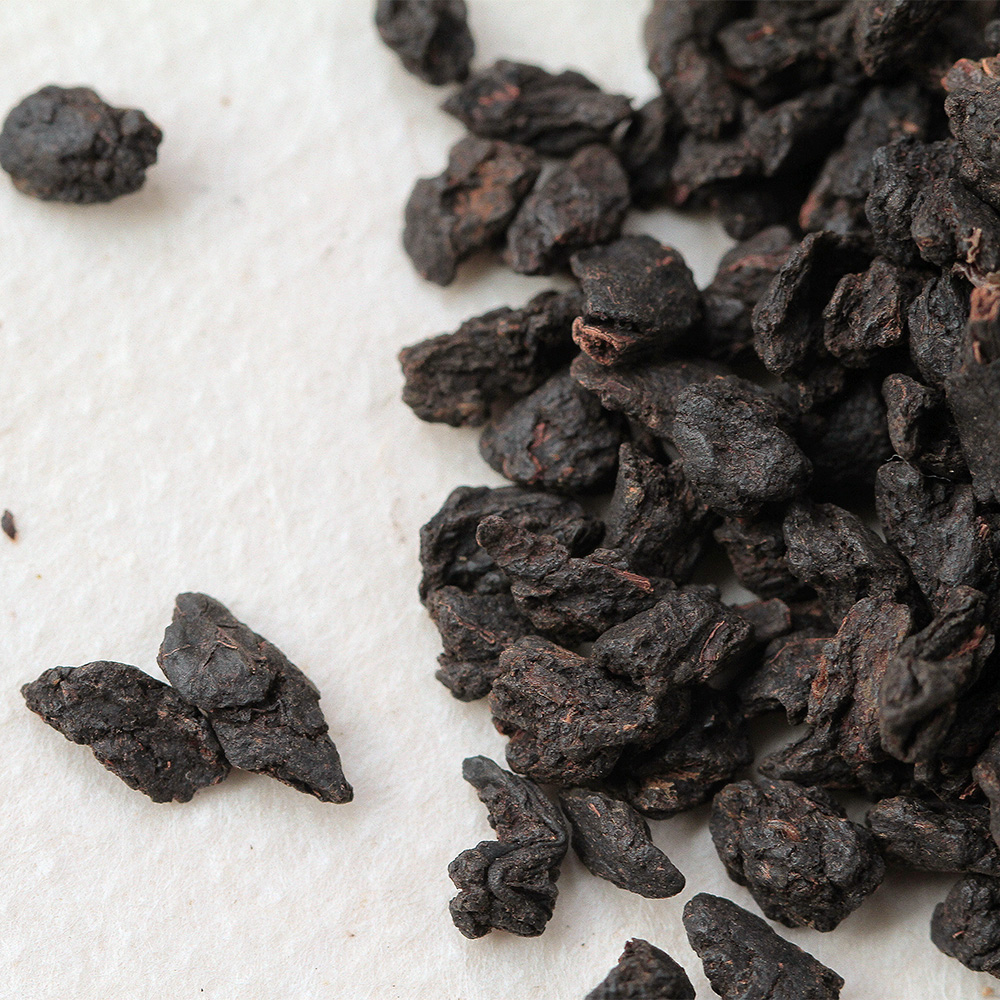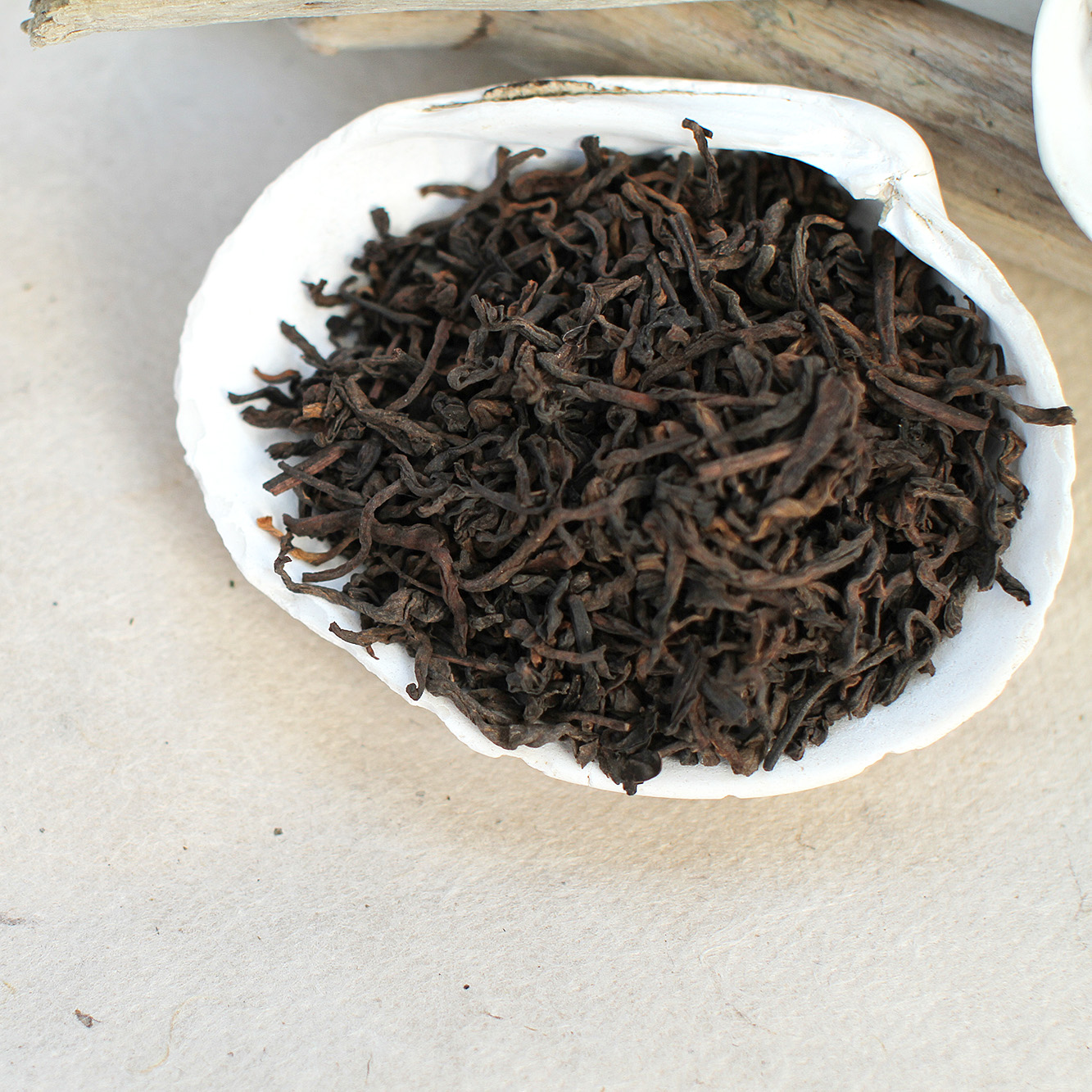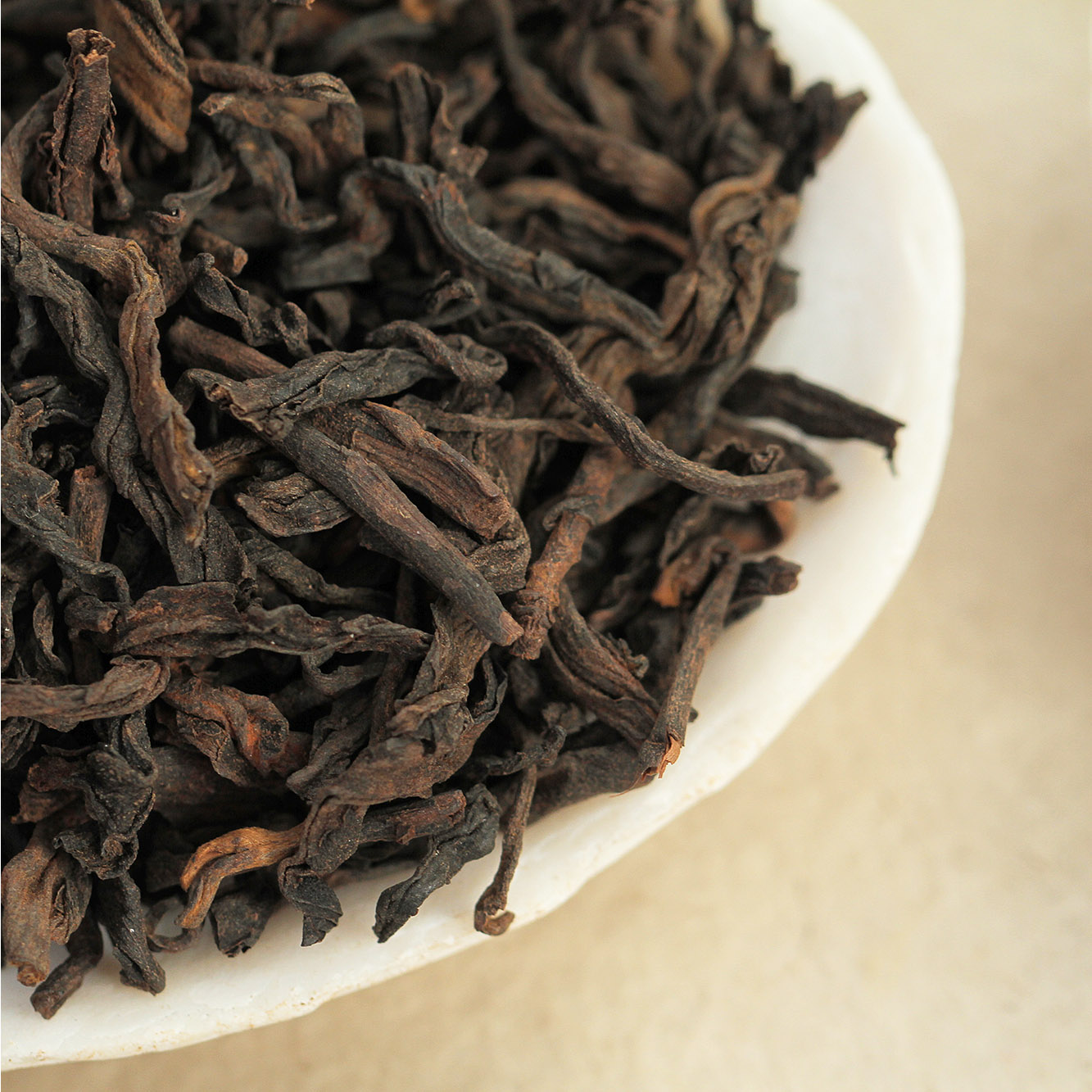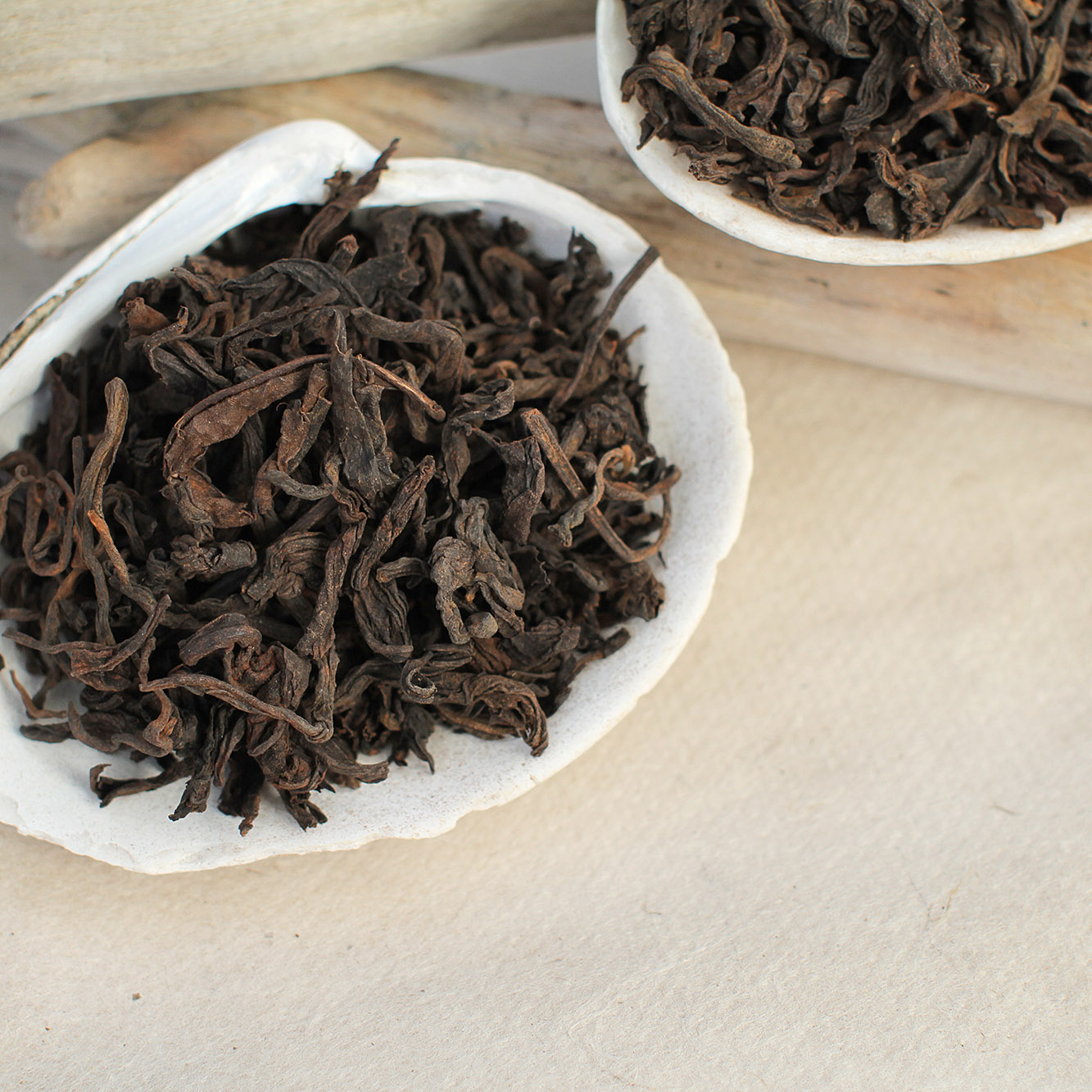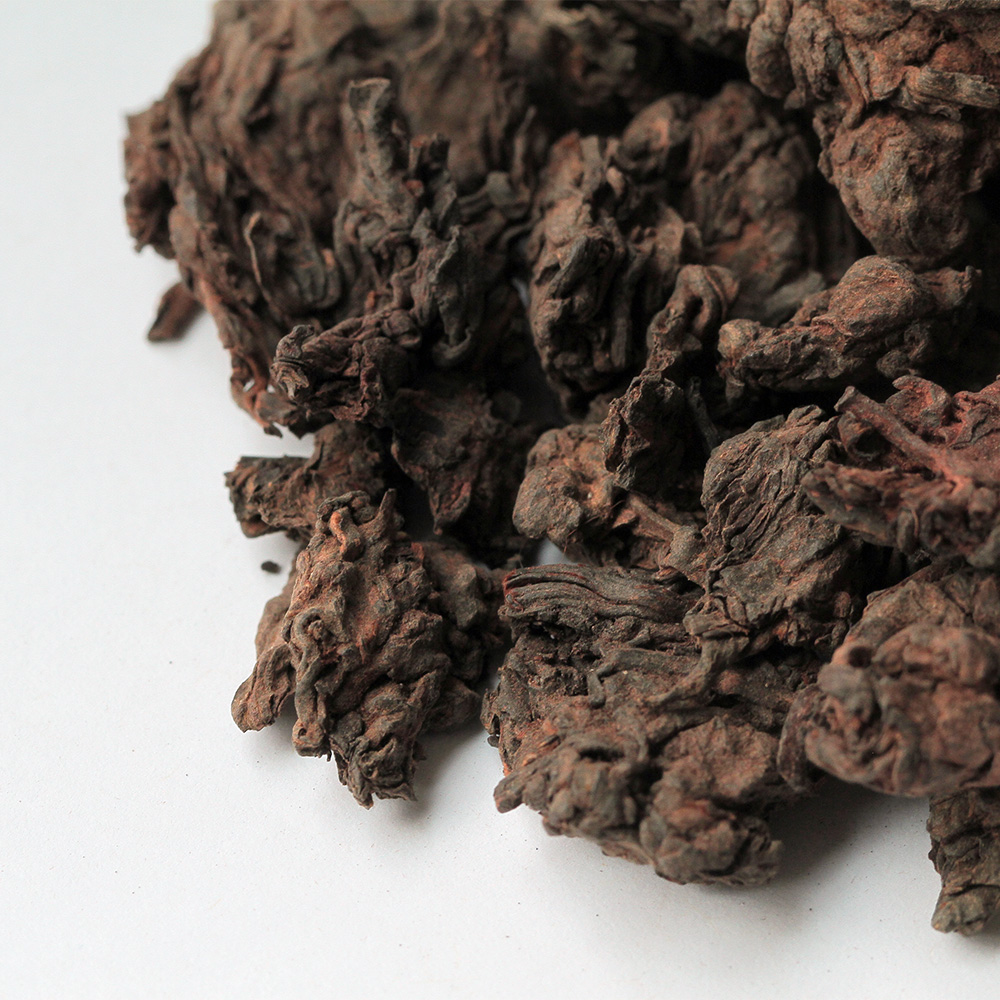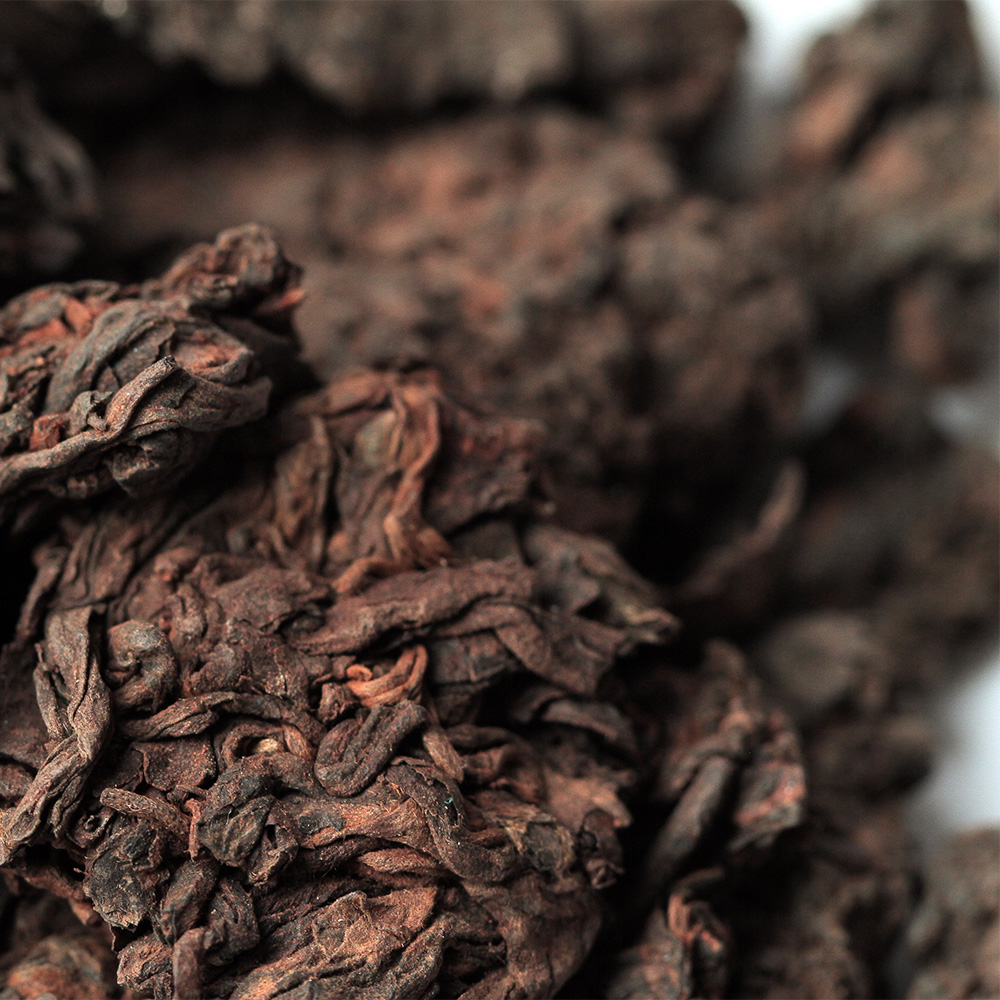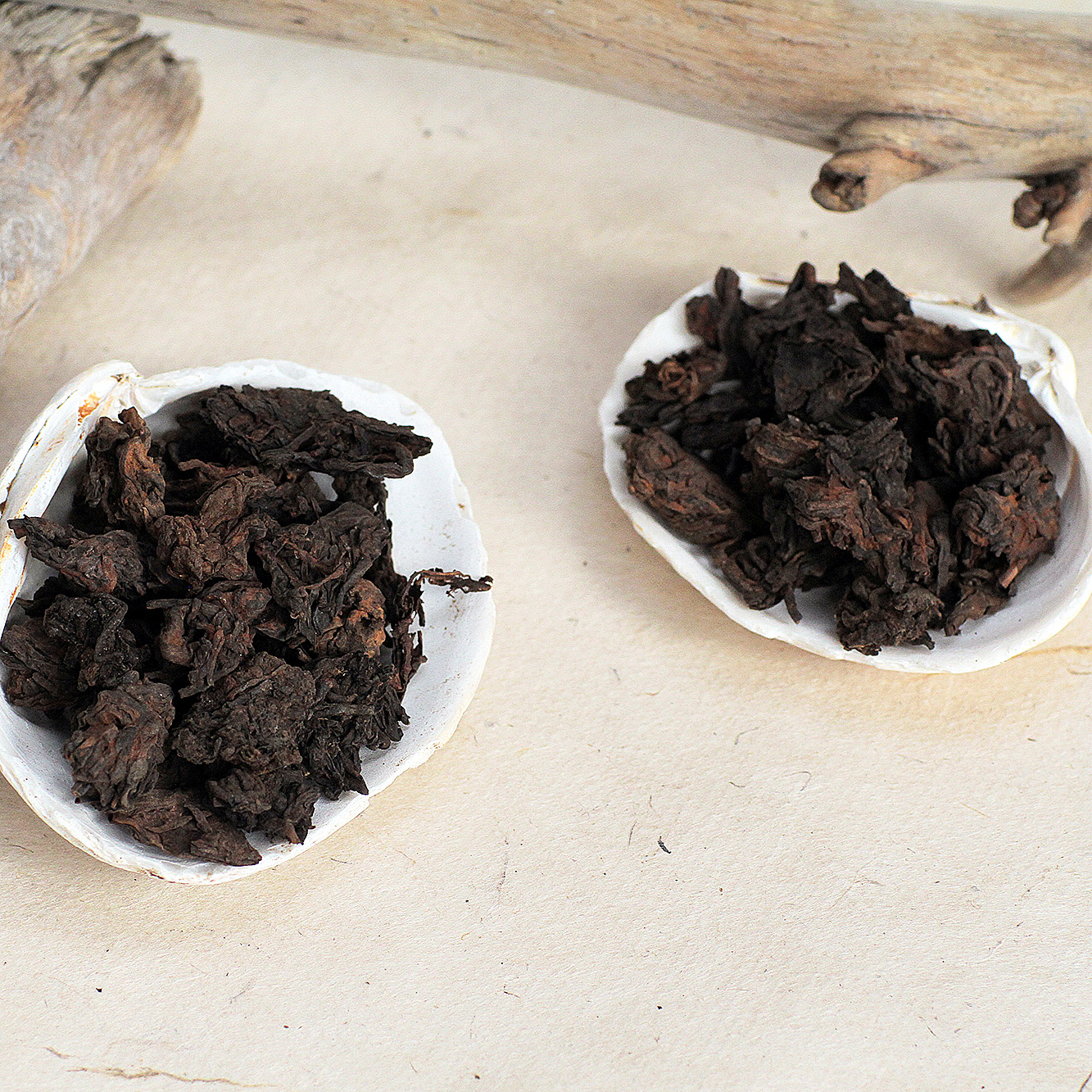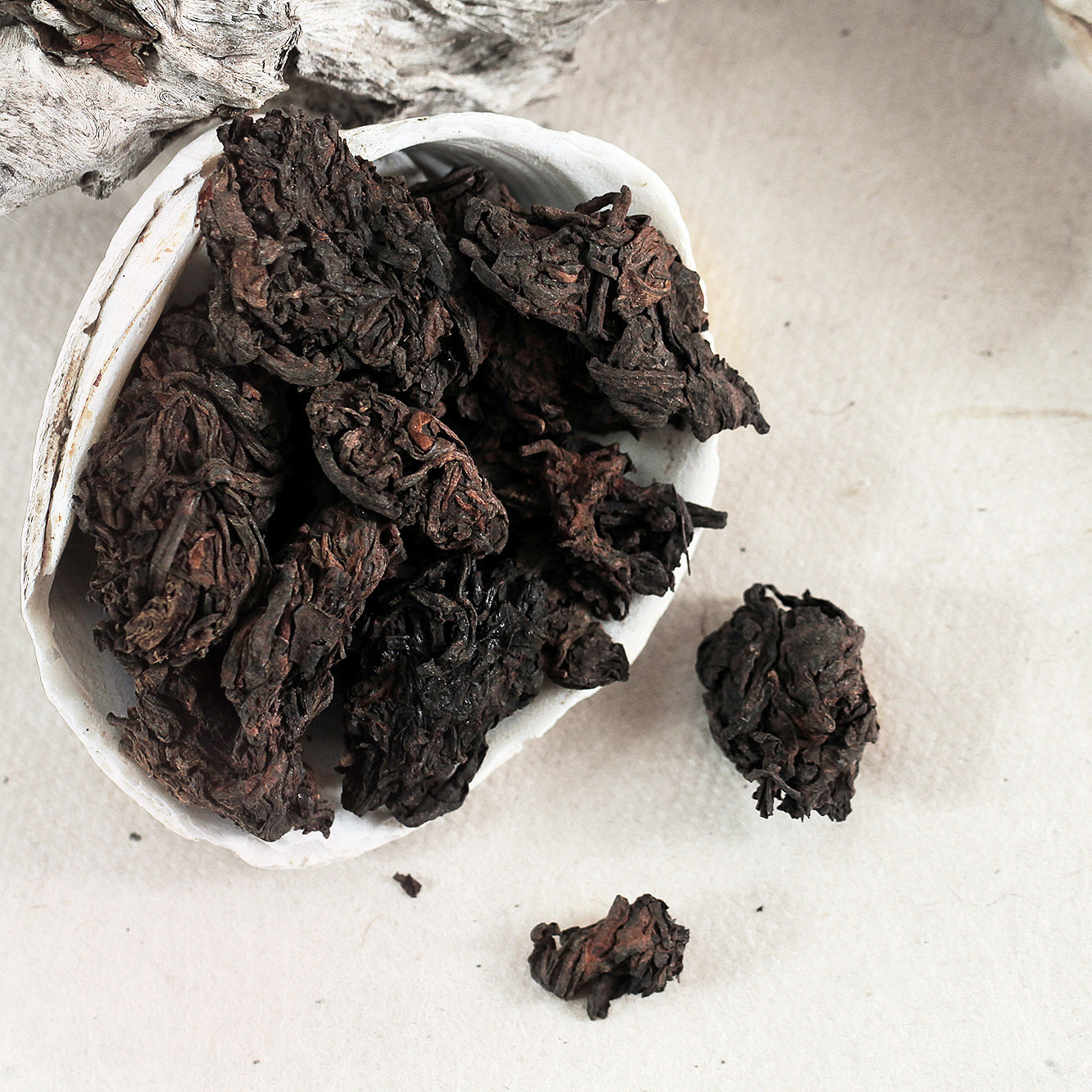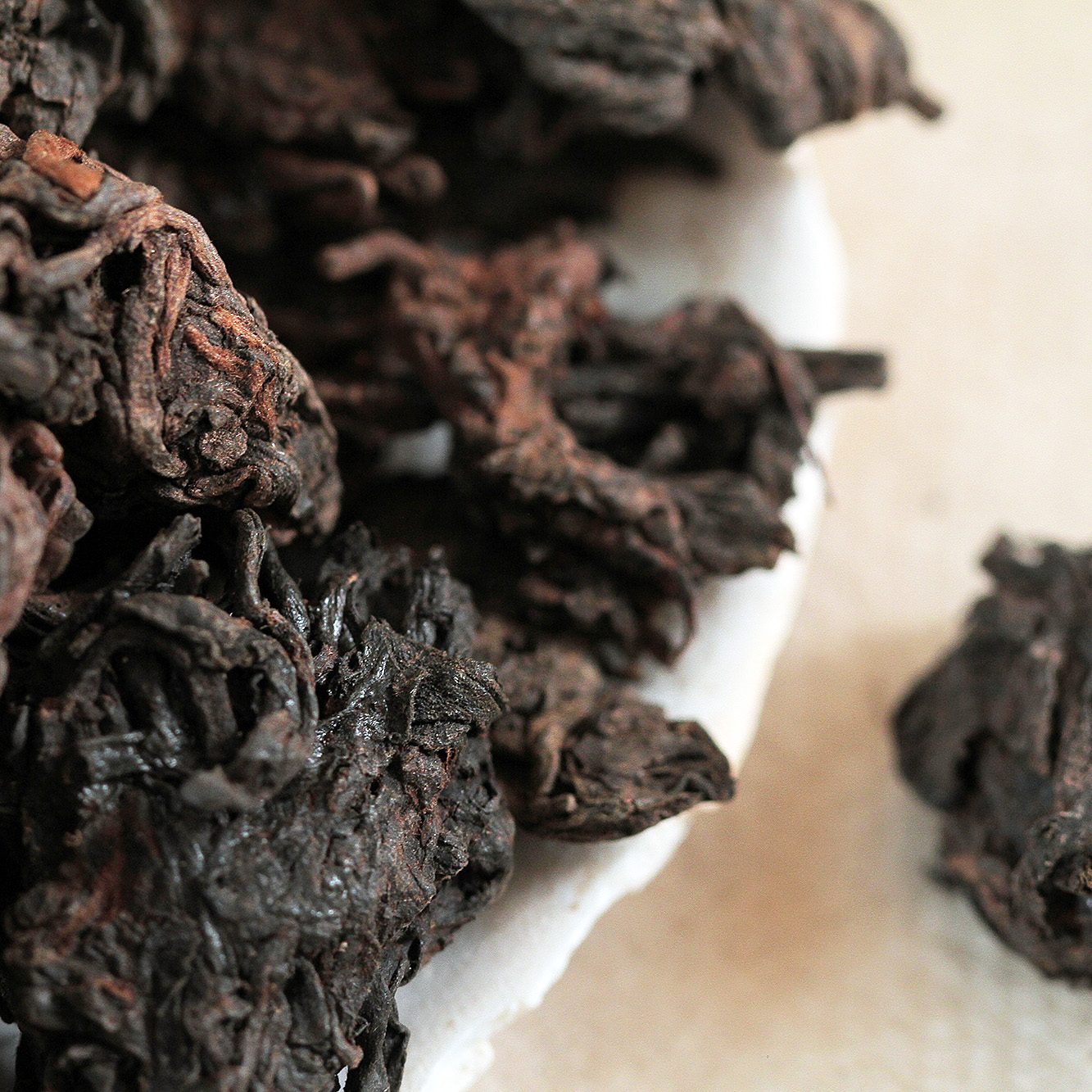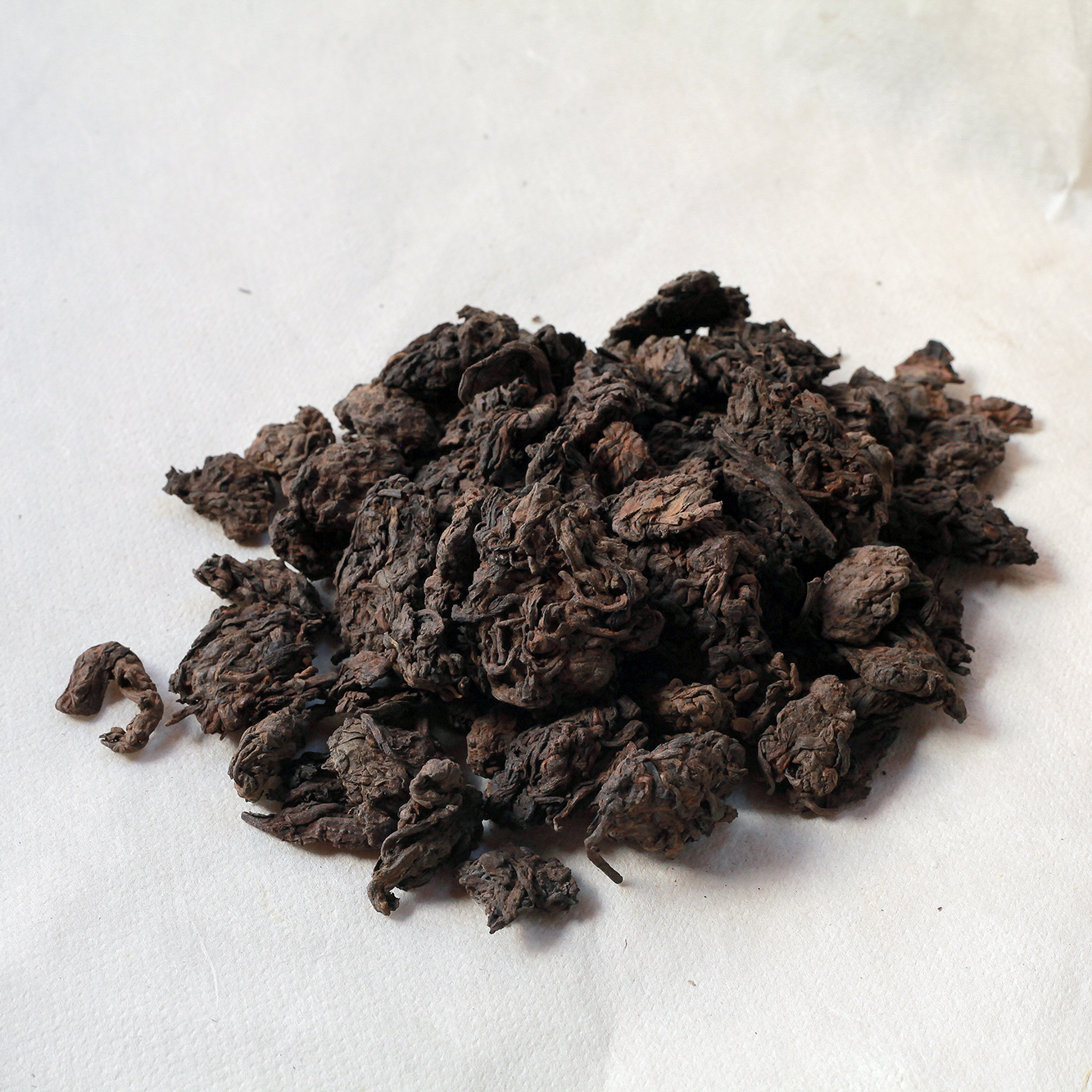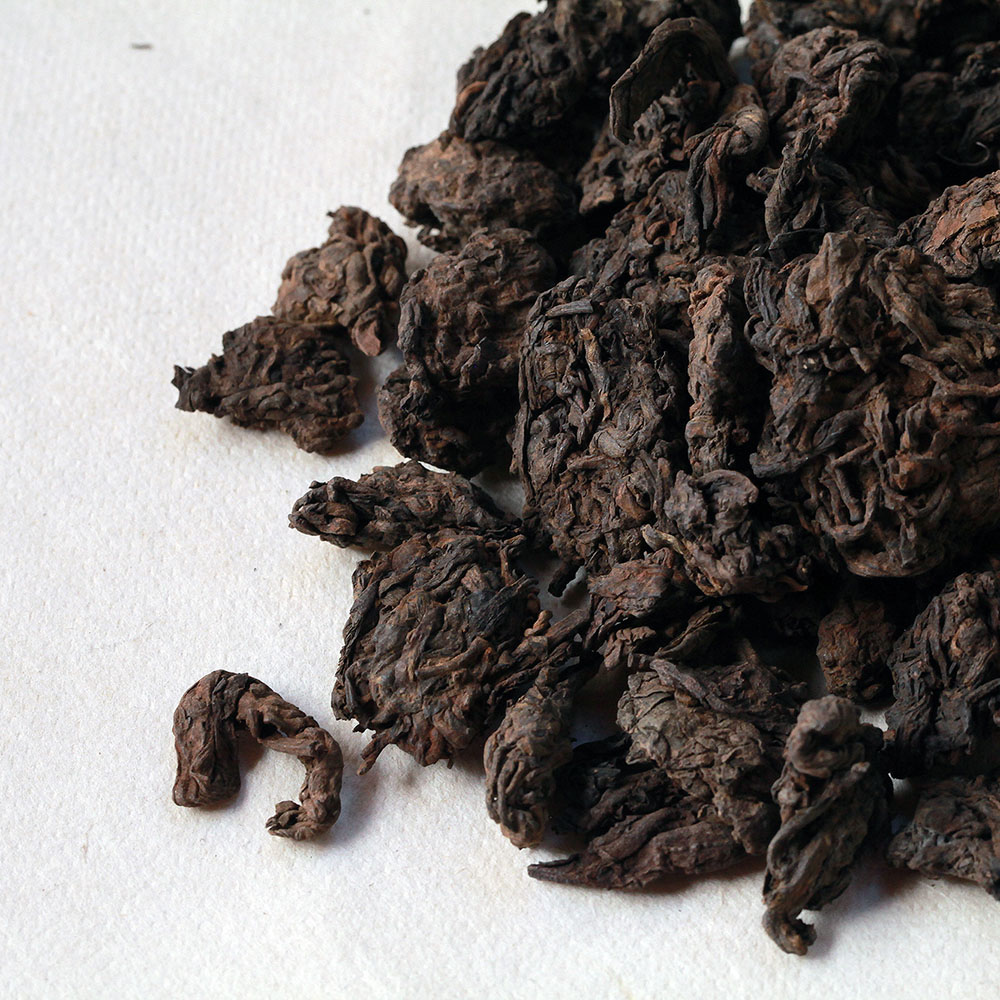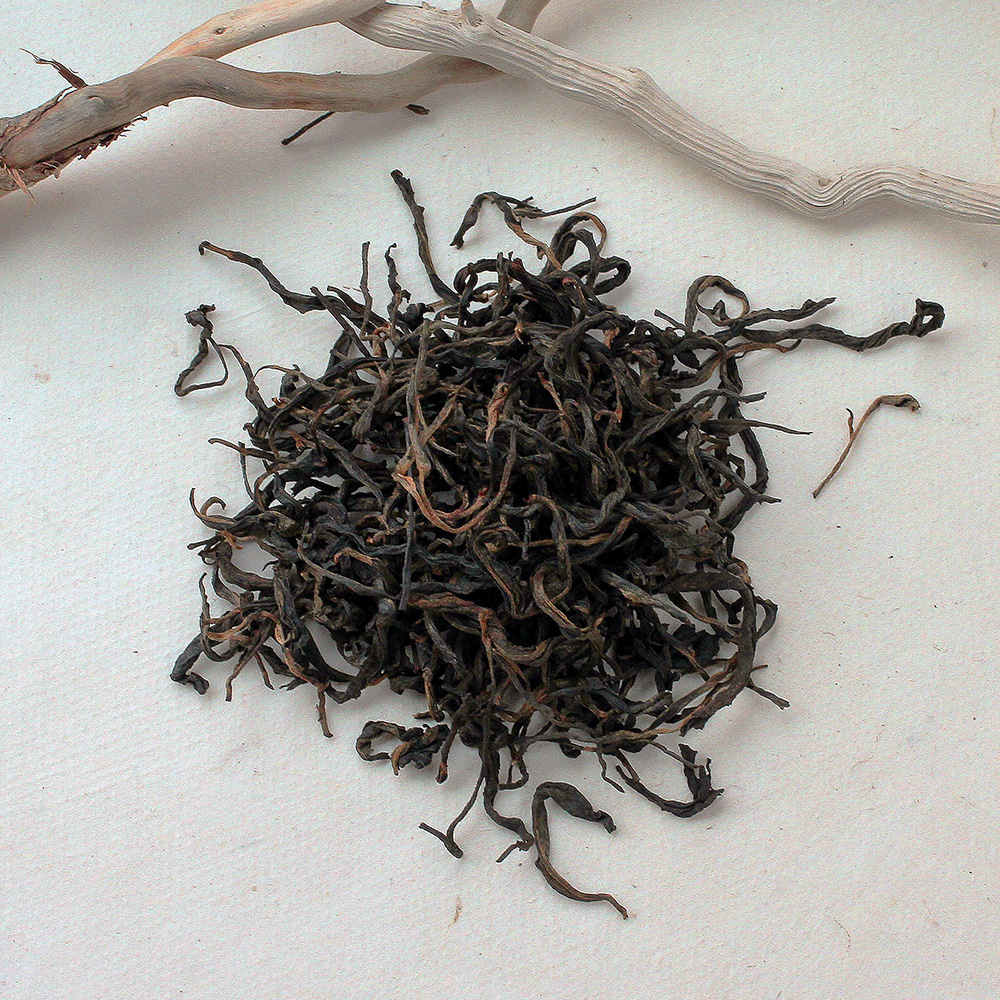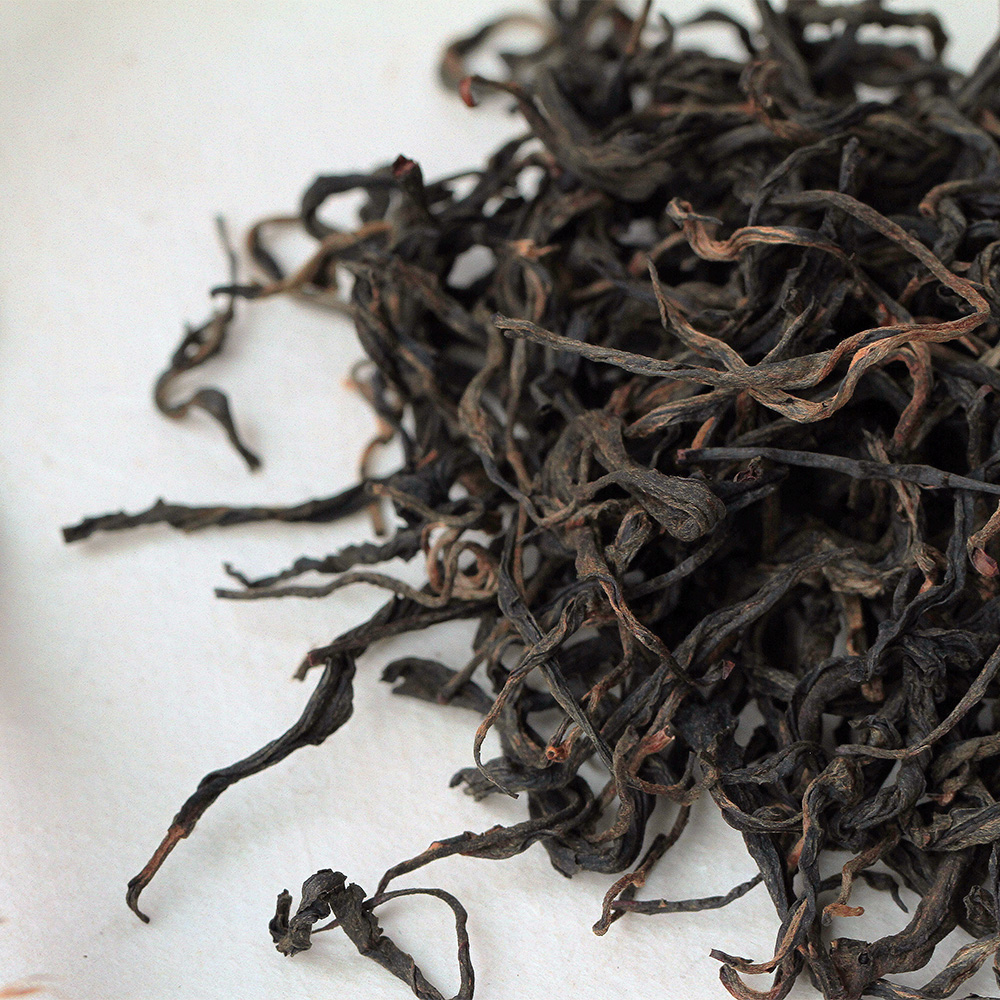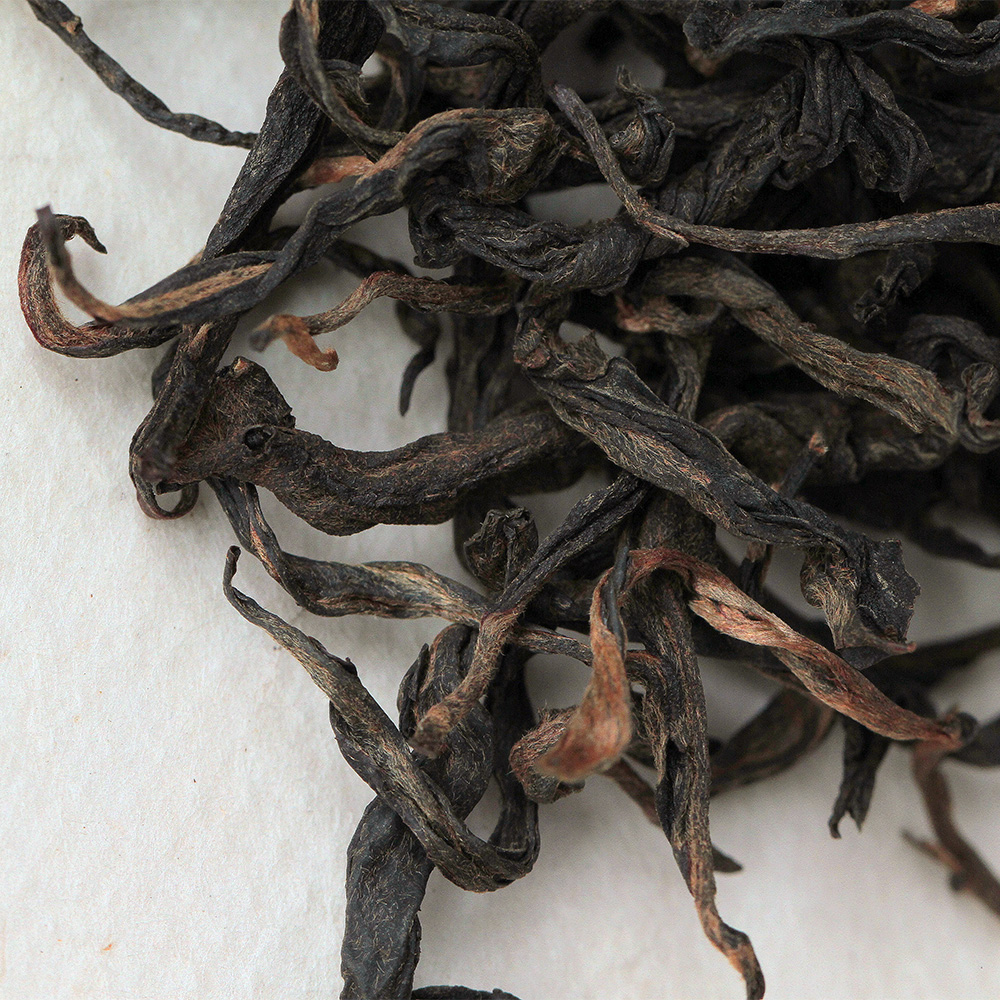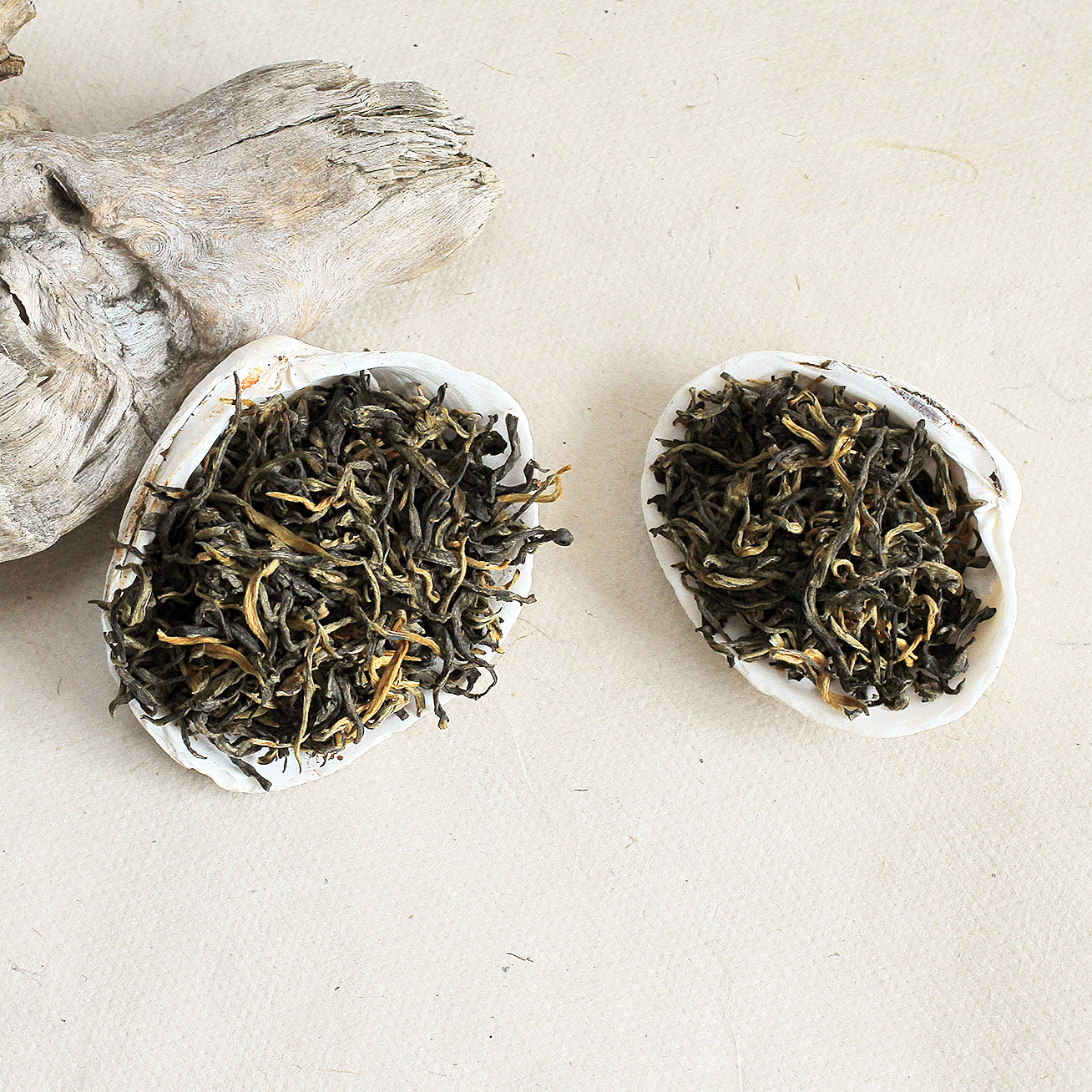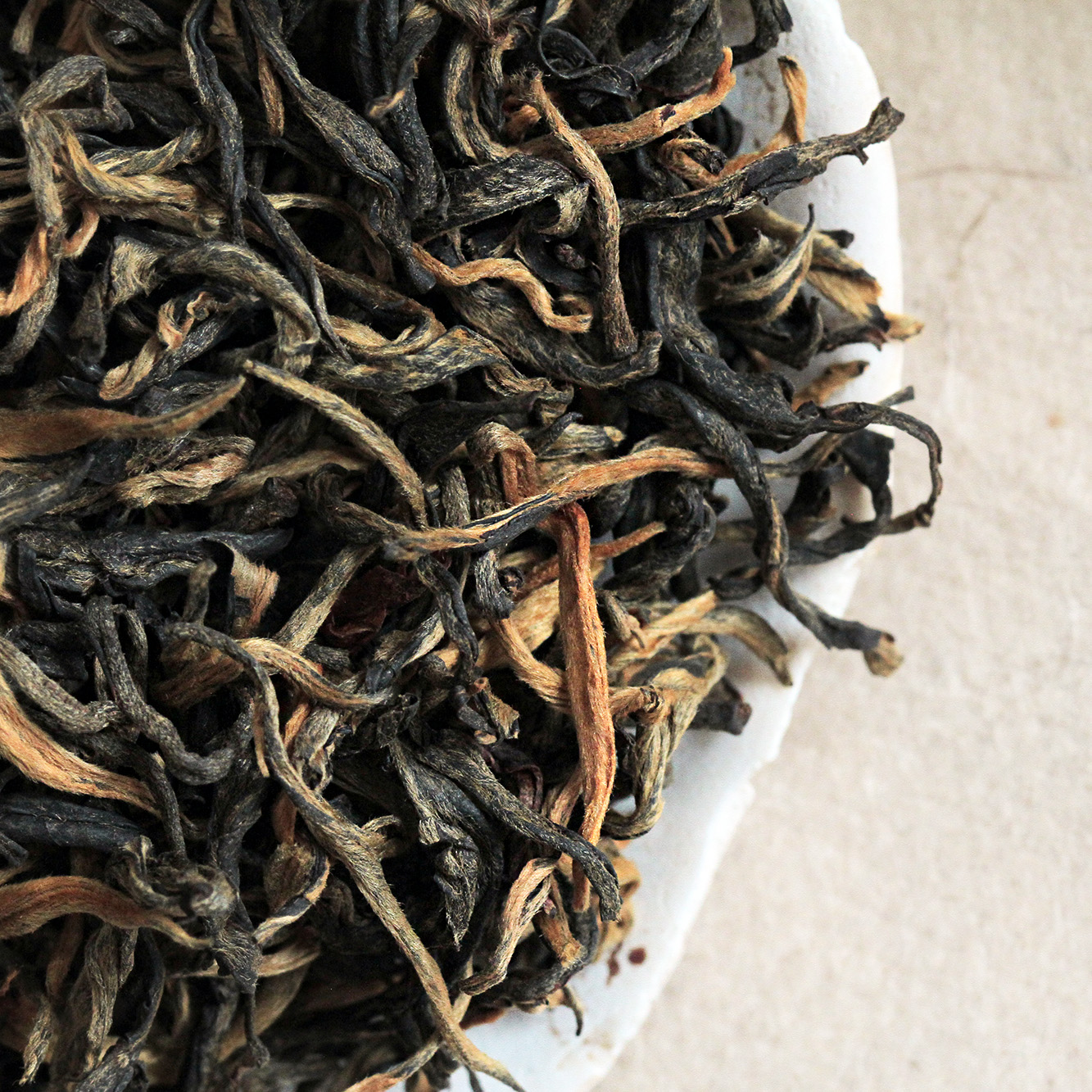“WYMMTEA’s private collection is distinguished by its adherence to traditional production methods and the use of premium fresh leaves from the native big-leaved arbour tea plants known as camellia sinensis var. Assamica. These leaves are carefully selected from ancient tea mountains and gardens along the banks of the Lancang River and Nu River in Yunnan. Each of our teas has a unique history and characteristic flavour and aroma, making them a must-try for any tea enthusiast or connoisseur.
There are two major categories in our pu-er tea collection – the sheng (raw) and the shou (ripe). Sheng pu-er is made of maocha, produced from withering, roasting, and sun drying the fresh tea leaves. When kept in storage, sheng pu-er will continue post-fermenting, evolving its flavour over time, and then become aged sheng pu-er after at least a decade. Shou pu-er is made once modern pile-fermentation technology known as wodui is applied to maocha, allowing enzymes to react with polyphenols, sugar, and protein in tea leaves under a controlled humidity and temperature, which rapidly enables the tea to possess rice-milk-like smoothness and sweetness, which characterize the flavours of aged sheng pu-er.
Pu-er’s quality and aged appeal become increasingly prominent after long storage periods, which grants them the title “drinkable vintage”. ”
sheng (raw) pu-erh
Traditionally, each sheng pu-erh is named after their birthplace, whether it is a mountain or a village. Unlike most pu-erh from plantation, our pu-erh is made from the leaves of ancient trees. Only pu-erh tea made from trees over 200 years old are considered ancient tree pu-erh. Ancient trees do not require maintenance, therefore are free of pesticides and fertilizers - real organic.
MANGNUO TENGTIAO "CANE TEA", 2014 FIRST SPRING
This is WYMM’s signature tea. Handmade with premium first flush of 2014 spring from Mangnuo village, this sheng pu-erh brews bright golden with a vegetal, minty and honey flavour, and with the aroma of fresh mown grass in the morning. The tea is filled with powerful and masculine chaqi. There is a pronounced bitter taste that lingers in back of the tongue with hints of astringency in the initial steeps, which are slowly replaced with a honey aftertaste. The liquor is heady because of the ultra concentrated nutrients in this tea. Each serving of this tea can last up to 20 steeps.
This single state tea is sold nowhere else; grown only in the ancient tea gardens around town of Mengku, located in Shuangjiang county of Yunnan province in China, these 200 to 300 year-old trees have distinct branch shape differentiating them from the rest of the tea trees in China. The name Tengtiao "Cane Tea" was coined by Zhan Yingpei, an acclaimed scholar specializing in Yunnan tea culture. The name implies that the shape of branches of this type of tea trees is similar to cane or rattan. Since the Qing dynasty, these trees have been shaped using a special technique that trims off all the excessive sub-branches and bigger leaves, leaving only two fresh tea buds per branch. Over generations of painstaking care by the local tribes, the branches have grown long and slender, similar to the shape of cane or rattan, hence the name. The technique for growing, trimming and picking the tea, concentrates all the tea nutrients within the two tea buds in every branch, creating fragrance unseen in most pu-erh. Local tribes only pick one tea bud from each branch at a time, leaving the other one to grow for next round’s harvest. The production of this tea is very low as a result of special trimming and picking methods – many more trees are needed to collect the same amount of buds. However the harvested tea buds are very neat and delicate, without any tough stalk or old leaves. Each of the sun-dried tea buds is covered with very dense fine hair that shimmers under the sun. The final product – Qizibing Cha is presentable and highly sought after for collection.
MANGNUO TENGTIAO "CANE TEA", 2014 FIRST SPRING
MANGNUO TENGTIAO “CANE TEA”, 2015 FIRST SPRING
Handmade with premium first flush leaves of 2015 spring from Mangnuo village, this sheng pu-erh brews bright golden with a vegetal, minty and honey flavour. The tea is filled with powerful chaqi and the aroma of freshly mown grass. There are hints of astringency in the initial steeps, which are quickly replaced with a honey aftertaste. The liquor is heady because of the concentrated nutrients in this tea.
Compared to our signature sheng pu-erh, Mangnuo Tengtiao from 2014 First Spring, this year’s version possesses a litter lighter fragrance and aroma. Due to an unusual rainfall in the winter of 2014, the spring buds grew a lot faster than before, resulting a milder taste in the 2015 spring harvest.
Grown only in the ancient tea gardens around town of Mengku, located in Shuangjiang county of Yunnan province in China, these 200 to 300 year-old trees have distinct branch shape differentiating them from the rest of the tea trees in China. The name Tengtiao "Cane Tea" was coined by Zhan Yingpei, an acclaimed scholar specializing in Yunnan tea culture. The name implies that the shape of branches of this type of tea trees is similar to cane or rattan. Since the Qing dynasty, these trees have been shaped using a special technique that trims off all the excessive sub-branches and bigger leaves, leaving only two fresh tea buds per branch. Over generations of painstaking care by the local tribes, the branches have grown long and slender, similar to the shape of cane or rattan, hence the name. The technique for growing, trimming and picking the tea, concentrates all the tea nutrients within the two tea buds in every branch, creating fragrance unseen in most pu-erh. Local tribes only pick one tea bud from each branch at a time, leaving the other one to grow for next round’s harvest. The production of this tea is very low as a result of the painstaking trimming and picking methods – many more trees are needed to collect the same amount of buds. However the harvested tea buds are very neat and delicate, without any tough stalk or old leaves. Each of the sun-dried tea buds is covered with very dense fine hair that shimmers under the sun. The final product – Qizibing Cha is presentable and highly sought after for collection.
MANGNUO TENGTIAO “CANE TEA”, 2015 FIRST SPRING
JINGMAI, 2013 FIRST SPRING
Handmade with tea leaves picked from Jingmai mountain in the first spring of 2013, this sheng pu-erh brews bright golden liquor with a heady orchid aroma and woody, leafy, mineral flavours. Concentrated nutrients from the first spring picks of 2011 delivers opulent aroma and intense flavour that is reminiscence of wilderness of Jingmai mountain.
Located in the Lancang Lahu autonomous county in southwestern Yunnan province, Jingmai mountain has 1800 years history of man-cultivated tea. Ancient tea gardens span an area of 28,000 mu, that is equivalent to 18.67 sq km or 4600 acres of land. Jingmai literally means “new city” in the Dai language. Jingmai mountain is composed of Jingmai, Mangjing, Manghong and six other villages occupied by Hani, Dai and Bulang ethnic groups. Jingmai mountain is considered one of the top production region of ancient tree pu-erh, even though being located outside of Xishuangbanna prefecture.
Originally there were no tea trees on the mountain. In the 7th century, the first Bulang chieftain in Jingmai village named Bayanleng directed his people to tea tree planting. Bayanleng was a leader of great vision. Once he explained to the tribe, “If I leave you with livestock, they may die from diseases; if I leave you with gold and silver, they will be used up; only if I leave you all with tea trees, they can sustain our descendants and will never be depleted.” His people took his word. Generations of persistence and hard work generate what we see now – mountain after mountain of ancient tea trees that rank Jingmai on the top of the world’s list for its scale, area and production of ancient tree pu-erh.
JINGMAI, 2013 FIRST SPRING
MAHEI, 2011 SPRING
Hand made with tea leaves picked from Mahei village in the spring of 2011, this sheng pu-erh brews bright yellow liquor with a delicate taste and silky texture. The tea is full-bodied with minimal astringency and bitterness, and brings back a prolonged honey-like aftertaste.
The village of Mahei is located in Yiwu mountain of Mengla county in Xishuangbanna autonomous prefecture. Yiwu is the biggest of the six great ancient tea mountains. The name means “the habitat of beautiful snake deity” in the local Dai language. The ancient Pu people started planting tea trees in the region as early as the Tang dynasty (618-907). During Qianlong period (1711-1799) of Qing dynasty, Pu’er Fu (nowadays Xishuangbanna) relaxed the monopolization of pu-erh tea industry which gave thousands of Han people the opportunity to enter into Yiwu and to renovate the ancient tea gardens and to expand the production capacity of pu-erh tea. By the end of Qianglong period, the tea gardens stretched more than 100 km along the mountain ridges of Yiwu. The development of tea industry was so fast that new villages and tea gardens emerged everywhere. The large volume of tea traded and the ever-increasing demand for more quality pu-erh brought economic prosperity to the region.
Mahei village sits on a low-lying land surround by mountains. There used to be more than 50 households prior to 1935. Approximately 20 households were left in the 1930 to 1940 periods due to the decline of tea industry during the war. Nowadays there are close to 80 households.
MAHEI, 2011 SPRING
NANPO LAOZHAI, 2014 FIRST SPRING
This is a sheng pu-erh made from tea leaves handpicked from the Nanpo Laozhai village in the early spring of 2014. It brews light golden liquor with a mild aroma of almonds. Its flavors can be described as creamy, herbaceous and herbaceous, with hints of flowers.
This pu-erh hails from the Nanpo Laozhai village occupied by the Lahu minority group. Nanpo is one of the five villages governed under Bingdao Cunweihui in Mengku county. It is located on the west-bank mountains of the Nanmeng river that runs through this region. The oldest existing human-cultivated tea tree garden in Mengku county is located in Nanpo Laozhai, which is 5 km from the renowned Bingdao Laozhai village. Even though it did not receive the widespread fame and attention of its neighbor, it holds its own by providing unique array of flavors. Difference in the soil components and regional climate in each village create distinct flavors of tea.
NANPO LAOZHAI, 2014 FIRST SPRING
KUNLU, 2010 SPRING
This sheng pu-erh brews golden-yellow liquor, it gives a smooth mouth feel, and comes with a sweet aftertaste.
Kunlu Mountain is located within Ning’er Hani and Yi autonomous prefecture county in Pu’er city. Kun means “valley” and lu means “sparrow” in Dai minority group’s language, together Kunlu means a valley inhabited with sparrows. Kunlu Mountain sits at the end of the Wuliang mountain range, where Lancang and Honghe Rivers divide. Kunlu Mountain’s altitude ranges between 1410 and 2271 meters, and is considered one of the higher mountains within Pu’er city region. A combination of early-cultivated and wild-grown trees forms the ancient tea tree forest, which covers 10,122 mu (equivalent to 6.75 sqkm) on the mountain.
Kunlu Mountain once served as imperial tea garden for the Qing emperors over 200 years. After successful bureaucratization of Cheli Xuanweisi in 1729, E’ertai (Ortai), the governor-general of Yunnan-Guizhou-Guangxi tri-province, established a tribute tea factory in Ning’er village, Pu’er Fu (known nowadays as Xishuangbanna). Every year, only the best and most delicate tea buds harvested from Kunlu Mountain in early spring were sent into this factory, in which they were carefully pressed into shapes or processed into paste. These products were carefully supervised by feudal officials and guarded by soldiers, and were presented in front of the Qing emperors after a 6-month, 4100-km route done solely on horseback.
KUNLU, 2010 SPRING
GUAFENG ZHAI, 2013 SPRING
Guafeng Zhai is located in the Yiwu mountain of Mengla county in eastern Xishuangbanna. Guafeng Zhai is a stockade village occupied with nearly 1000 residents of Yao and Miao ethnic groups. It is only 4 kilometers away from the China-Laos border. Ancient tea trees are scattered in primeval forests that measure around 50 sqkm around Guafeng Zhai. These tea trees grow with thick canopy, as a result they are exposed to lesser direct sunlight and grow relatively slow. The climate nurtures a tea with strong chaqi that linger with a soft after taste of sweetness and makes one reminisce about the tea mountains and fields.
GUAFENG ZHAI, 2013 SPRING
DONG BANSHAN, 2014 FALL
Handmade with tea leaves picked from Dong Banshan (or Ma’an mountain) in the fall of 2014, this sheng pu-erh has a high floral fragrance similar to that of jasmine flowers, with fairly subtle intricacies in its taste. It is most represented by its initial vegetal taste, which soon transfers to a honey flavour. It is a sheng pu-erh that can be easily enjoyed on a daily basis.
Mengku town is located at the most northern region of Shuangjiang county, under Lincang city in southwestern Yunnan. The total area of the town is 475.3 sq km; two mountains, one river and one flatland characterize its geographical features. Nanmeng river flows in between Ma’an and Bangma mountains. Ma’an mountain sits on the east-bank of river - the locals prefer calling it Dong Banshan, meaning east-bank mountain. Similarly, Bangma mountain is known as Xi Banshan (west-bank mountain) as it is located on the west-bank.
DONG BANSHAN, 2014 FALL
XI BANSHAN HUANGPIAN, 2014
Handmade with tea leaves picked from Xi Banshan in 2014, this well-balanced sheng pu-erh is represented by its initial vegetal taste, which soon transfers to a honey flavour. It is a sheng pu-erh that can be easily enjoyed on a daily basis.
Mengku town is located at the most northern region of Shuangjiang county, under Lincang city in southwestern Yunnan. The total area of the town is 475.3 sq km; two mountains, one river and one flatland characterize its geographical features. Nanmeng river flows in between Ma’an and Bangma mountains. Ma’an mountain sits on the east-bank of river - the locals prefer calling it Dong Banshan, meaning east-bank mountain. Similarly, Bangma mountain is known as Xi Banshan (west-bank mountain) as it is located on the west-bank.
The name Huangpian literally means “yellow leaves” in Chinese. The picking standard of pu-erh tea has been 1 bud, with up to 3 leaves, in rare occasions it goes up to 4 leaves. During processing, smaller and suppler tea buds are easily getting rolled up into cord-like strands, whereas the bigger and broader leaves aren’t. As a result the shape of the 3rd and 4th leaves is not as ideal after processing. For the best aesthetics of final product to the consumers, tea farmers usually filter out these bigger leaves so that the remaining ones are neat and symmetrical when pressed into bing. These bigger leaves are often kept by the tea farmers themselves and are rarely found in the market. Unknown to the general public, these larger and plumpish leaves are more flavourful and sweeter as it has been grown on the trees for a longer period of time. Laohuangpian undergoes the same production method as sheng pu-erh and possesses the same quality. This tea is worth trying if you wonder what the local ethnic groups and tea farmers from the Yiwu mountain are enjoying on their own.
XI BANSHAN HUANGPIAN, 2014
LINCANG DAXUESHAN, HUANGPIAN, 2014
Made with tea leaves picked from Daxueshan in 2014, this sheng pu-erh appears dark olive green, and brews bright orange liquor with a vegetal aroma, full-bodied texture and long-lasting sweet aftertaste. This tea is darker coloured and less hairy than pu-erh from other regions in Yunnan. It is a very soothing tea at an affordable price that makes it ideal to be enjoyed on a daily basis.
Daxueshan literally means “big snow mountain”. It is located northwest to Mengku town, Shuangjiang county, within Lincang city. It is considered as the birthplace of Mengku region’s large-leaved camellia sinensis var. assamica. Wild ancient tea trees of up to 1000 years old cover the mountain from an elevation of 2200 to 2750 m, which puts Daxueshan at the top of the list for the highest and densest wild ancient tea colonies in the world.
Due to the vast temperature difference between day and night, tea trees on Daxueshan come with more sparsely distributed leaves, which sometimes lead to more huangpian being produced. The name huangpian literally means “yellow leaves” in Chinese. Some also call it laohuangpian, meaning “old yellow leaves”. During production, tea farmers filter out bigger leaves so that the remaining ones are neat and symmetrical when pressed in to bing. Laohuangpian undergoes the same production method as sheng pu-erh and possesses the same quality. Unknown to the general public, these larger and plumpish leaves are more flavourful and sweeter as it has been grown on the trees for a longer period of time. This tea is worth trying if you wonder what the local tribe and tea farmers in Lincang region are enjoying on their own.
LINCANG DAXUESHAN, HUANGPIAN, 2014
BINGDAO LAOZHAI HUANGPIAN, 2014
Handmade with tea leaves picked from Bingdao Laozhai in 2014, this sheng pu-erh brews a bright golden liquor. It has notes of cut hay and earth in its aroma, complimented with almond and buttery flavours.
We were lucky enough to obtain some of these huangpian which give insights into the highly sought after Bingdao Laozhai sheng pu-erh. Bingdao Laozhai is a place renowned in the Yunnan tea industry. Due to its premium quality, rich history, high reputation and limited supply, pu-erh from Bingdao Laozhai had always been highly sought after. Because of that, the price of pu-erh from this village would go into the thousands. Please visit our blog post to learn more about it.
These huangpian are picked from the same ancient trees as the standard pu-erh from Bingdao Laozhai, the only difference being that it is less aesthetically pleasing; the bigger leaves (huangpian) are filtered out so that the remaining leaves are neat and symmetrical when pressed into cakes. These bigger leaves are often kept by the tea farmers for personal consumption and are rarely found in the market. Even though huangpian does not have the tidy appearance of its counterparts, it possesses similar taste characteristics and is sometimes considered more flavourful as the leaves spent longer period of time growing on the trees.
BINGDAO LAOZHAI HUANGPIAN, 2014
shou (ripe) pu-erh
Shou pu-erh is produced from applying the modern pile-fermentation technology known as wodui on maocha. By allowing enzymes to react with polyphenols, sugar and protein from tea leaves under controlled humidity, temperature and environment, it renders rice-milk-like smoothness and sweetness to the flavours of tea, which characterize the flavours of aged sheng pu-erh.
Shou pu-erh has a warming property that makes it go very easy on the stomach. It demonstrates a broad spectrum of health benefits including lowering cholesterol, breaking down grease and promoting healthy weight loss.
Loose-leaf pu-erh is evaluated based on suppleness, density and lustre and is classified into golden buds, royal, gift, premium, first, third, fifth, seventh and ninth grade. Simply put, golden buds grade pu-erh contains the smallest buds possible while ninth grade contains the largest leaves. Right now we have first to seventh grades. There is marginal difference in the taste; first grade has a slightly stronger and woodier flavour, while the seventh grade has a milder and sweeter flavour. The third and fifth grades fall in between the spectrum.
TEA STEM
Tea stems are selected from piles of shou pu-erh, which are produced by applying the modern pile-fermentation technology known as wodui on maocha. The wodui process allows enzymes to react with polyphenols, sugar and protein from the leaves and stem under an environment with controlled humidity and temperature which adds milk-like smoothness and sweetness to the flavours of the tea. Stems serve as gateways for nutrients to be transported back and forth, and would have similar flavors as the leaves, if not more.
Traditionally, pu-erh and other dark teas are pressed for the ease of storage and transportation. The rigid stems ensure there’s suitable amount of voids in the pressed tea for oxygen, which plays an important role in the natural fermentation.
TEA STEM
SUIYINZI SHATTERED SILVER, 2015
This is a shou pu-erh that is processed from Laochatou. It earned the name from the resemblance to the shattered silver ingots that were once used as a currency in ancient China.
Chatou means “tea nuggets”, which is the clustered tea produced during the fermentation process of shou pu-erh. The pile is turned from time to time to reduce the high temperature within and to prevent over-fermentation. Pectin released from the tea leaves by this turning motion agglomerates with other leaves within the pile to form chatou.
The ones at the bottom of the fermentation pile are pressed more tightly due to the weight, and their fermentation level is higher. These small and compact chatou are then hand picked, cut and polished to become the shattered silver. One batch of fermentation process produces 1-1.5% of chatou by weight, and less than 0.25% shattered silver.
Tea leaves high in sugar and pectin form nuggets more easily. Compared to loose leave shou pu-erh from the same batch, chatou has a higher fermentation level with higher level of sugar, therefore producing richer liquid. Shattered silver is even more ripe than chatou, hence its darker colour and denser texture. This renders a smoother and warmer mouth feel, along with a honey-like taste filled with aroma of dates and sticky rice.
SUIYINZI SHATTERED SILVER, 2015
SUIYINZI SHATTERED SILVER, sticky rice fragrance, 2018
This is a shou pu-erh that is processed from Laochatou. It earned the name from the resemblance to the shattered silver ingots that were once used as a currency in ancient China.
The leaves of a herbal plant indigenous to Mengla county in Xishuangbanna prefecture called Semnostachya Menglaensis Tsui is added to develop a basmati rice flavour that couples nicely with the mellowness of this tea. The plant is commonly known as the “sticky rice fragrance plant” in China. It is a traditional custom of the local Dai ethnic group to add this herbal plant to sheng and shou pu-erh to elevate the fragrance. Moderate amount of the herb helps to clear away heat and strengthen the stomach.
Chatou means “tea nuggets”, which is the clustered tea produced during the fermentation process of shou pu-erh. The pile is turned from time to time to reduce the high temperature within and to prevent over-fermentation. Pectin released from the tea leaves by this turning motion agglomerates with other leaves within the pile to form chatou.
The ones at the bottom of the fermentation pile are pressed more tightly due to the weight, and their fermentation level is higher. These small and compact chatou are then hand picked, cut and polished to become the shattered silver. One batch of fermentation process produces 1-1.5% of chatou by weight, and less than 0.25% shattered silver.
Tea leaves high in sugar and pectin form nuggets more easily. Compared to loose leave shou pu-erh from the same batch, chatou has a higher fermentation level with higher level of sugar, therefore producing richer liquid. Shattered silver is even more ripe than chatou, hence its darker colour and denser texture. This renders a smoother and warmer mouth feel, along with a honey-like taste filled with aroma of dates and sticky rice.
SUIYINZI SHATTERED SILVER, STICKY rice fragrance, 2018
MENGHAI WANGSHUJI, 2008, FIRST GRADE
Tender and fine buds from high mountains in Menghai County, located in west of Xishuangbanna Dai Autonomous Prefecture in Yunnan province, are harvested to make the tea in 2008. Pu-erh has the potential to ferment over time, and this tea has post-fermented for 10 years since production. Post-fermentation renders richer aroma and darker wine colour. This shou pu-erh brews dark red liquor with a smooth and sweet flavor and long-lasting jasmine rice aroma.
MENGHAI WANGSHUJI, 2008, FIRST GRADE
MENGHAI WANGSHUJI, 2008, THIRD GRADE
Buds from high mountains in Menghai County, located in west of Xishuangbanna Dai Autonomous Prefecture in Yunnan province, are harvested to make the tea in 2008. Pu-erh has the potential to ferment over time, and this tea has post-fermented for 10 years since production. Post-fermentation renders richer aroma and darker wine colour. This shou pu-erh brews dark red liquor with a rich honey flavor and long-lasting jasmine rice aroma.
MENGHAI WANGSHUJI, 2008, THIRD GRADE
MENGHAI WANGSHUJI, 2008, FIFTH GRADE
Leaves from high mountains in Menghai County, located in west of Xishuangbanna Dai Autonomous Prefecture in Yunnan province, are harvested to make the tea in 2008. Pu-erh has the potential to ferment over time, and this tea has post-fermented for 10 years since production. Post-fermentation renders richer aroma and darker wine colour. This shou pu-erh brews dark red liquor with a rich honey flavor and long-lasting jasmine rice aroma.
MENGHAI WANGSHUJI, 2008, FIFTH GRADE
MENGHAI WANGSHUJI, 2008, SEVENTH GRADE
Full tea leaves from high mountains in Menghai County, located in west of Xishuangbanna Dai Autonomous Prefecture in Yunnan province, are harvested to make the tea in 2008. Pu-erh has the potential to ferment over time, and this tea has post-fermented for 10 years since production. Post-fermentation renders richer aroma and darker wine colour. This shou pu-erh brews dark red liquor with a rich honey flavor and long-lasting jasmine rice aroma.
MENGHAI WANGSHUJI, 2008, SEVENTH GRADE
ZHUANGLAOSHI LAOCHATOU, VARIOUS YEARS
This chatou is selected from shou pu-erh made in the past 10 years by Master Zhuang Jingli. Master Zhuang served as the Chief Quality Supervisor at Menghai Tea Factory, and is recognized as one of the leading masters fully proficient in the factory’s fermentation and blending techniques.
This shou pu-erh brews clear dark red liquor. Tea from various years renders full-bodied flavour with hints of dates and rice water. Chatou means “tea nuggets” whereas laochatou means “old tea nugget”. It is the clustered tea produced during the fermentation process (or wodui) of shou pu-erh. During this time, the pile has to be turned from time to time to reduce the high temperature within and to prevent over-fermentation. Pectin released from tea leaves by this turning motion agglomerates with other leaves within the pile to form chatou. Compared to loose leave shou pu-erh from the same batch, chatou has a higher fermentation level and nutrient contents that yields more infusions with richer liquid. This gives an impression that it is more aged, thus the name laochatou, meaning “old tea nuggets”. There is approximately only half a rice bowl of chatou to be found per 8kg of shou pu-erh.
ZHUANGLAOSHI LAOCHATOU, VARIOUS YEARS
MENGHAI LAOCHATOU, 2014
Made with maocha from Menghai in 2014, this shou pu-erh brews dark orange liquor, infused with dates and honey taste. Compared to our other shou pu-erh from 2008, this tea still needs some time to age and achieve its full potential.
Chatou means “tea nuggets” whereas laochatou means “old tea nugget”. It is the clustered tea produced during the fermentation process (or wodui) of shou pu-erh. During this time, the pile has to be turned from time to time to reduce the high temperature within and to prevent over-fermentation. Pectin released from tea leaves by this turning motion agglomerates with other leaves within the pile to form chatou. Compared to loose leave shou pu-erh from the same batch, chatou has higher fermentation level and nutrient contents that yields more infusions with richer liquid. This gives an impression that it is more aged, thus the name laochatou, meaning “old tea nuggets”. There is approximately only half a rice bowl of chatou to be found per 8kg of shou pu-erh.
MENGHAI LAOCHATOU, 2014
MELLOW LAOCHATOU, 2012
This shou pu-erh brews sienna liquor that gives out a thick aroma resembling jujube dates and jasmine rice, and a smooth and sweet taste like the rice wine.
Chatou means “tea nuggets” whereas laochatou means “old tea nugget”. It is the clustered tea produced during the fermentation process (or wodui) of shou pu-erh. During this time, the pile has to be turned from time to time to reduce the high temperature within and to prevent over-fermentation. Pectin released from tea leaves by this turning motion agglomerates with other leaves within the pile to form chatou. Compared to loose leave shou pu-erh from the same batch, chatou has higher fermentation level and nutrient contents that yields more infusions with richer liquid. This gives an impression that it is more aged, thus the name laochatou, meaning “old tea nuggets”. There is approximately only half a rice bowl of chatou to be found per 8kg of shou pu-erh.
MELLOW LAOCHATOU, 2012
DIANHONG (YUNNAN bLACK)
Black tea produced in Yunnan is more commonly referred as Dianhong, which means “Yunnan red” in Chinese. The production starts with fresh leaves from ancient tea tree, which then are rolled, fermented, dried and sieved into various grades. Like other black teas, Dianhong is fully fermented, and is considered one of the premium black teas in China.
MANZHUAN BLACK, 2018
Handmade with tea leaves picked from Walong Ancient Tea Garden, located on Manzhuan Mountain (one of the Six Great Ancient Tea Mountains) in Xishuangbanna Dai Prefecture. This black tea presents in black and golden slim strands. It brews bright orange liquor with prominent rose, honey and malty fragrances, accompanied by long-lasting sweet aftertaste.
Walong is a small hamlet belonging to the Manzhuang village, which is located in the Mengla county. It is less well known because of its remote location. The villagers perform low-level maintenance of the tea trees by leaving them untrimmed and unfertilized, and at most weed them once or twice a year. Along with its native ecological environment and steep slope, the village is hard to reach as it is connected by dirt roads only. To reach the tea fields, one would need to ride a motorcycle, walk, and even crawl and climb.
MANZHUAN BLACK, 2018
TENGTIAO BLACK, 2015
Handmade with Tengtiao maocha produced from Mengku town, Lincang city in the spring of 2015, this black tea appears in black and golden slim strands. It brews bright orange liquor with prominent rose, honey and malty fragrances, accompanied by long-lasting sweet aftertaste.
What distinguishes this black tea from the others is the type of tea tree from which it is produced. Tengtiao, meaning cane or rattan, is the name of a type of tea trees with very distinct slender and long branches. These 200 to 300 year-old trees can only be found in the ancient tea gardens around the town of Mengku, located in Shuangjiang county of Yunnan province in China. Since the Qing dynasty, these trees have been shaped using a special technique that trims off all the excessive sub-branches and bigger leaves, leaving only two fresh tea buds per branch for harvesting. The production is very low. Nonetheless this technique produces very neat and delicate buds, and concentrates all the tea nutrients within the two tea buds in every branch, creating fragrance unseen in most tea.
TENGTIAO BLACK, 2015
Puzzled on any unfamiliar terms? Look them up:

